A Precision Converter FPGA Integration Journey
This workshop goes through the whole stack for the integration of a precision converter using an FPGA.
Introduction
Customer Journey

Tools / Platforms are a customer choice, ADI ports to “current” development environment/kit.

Maintenance is an ADI burden. Customer don’t start their designs at the same time, and want to use the latest and greatest.
COS Reference Design “Donut Hole” Strategy
Surround others processor, FPGA, micro ADI components Reference design creates stickiness Customer experiences low friction Leverage ecosystems Develop/participate in viable communities / ecosystems:
Linux kernel (1.3 Billion users)
GitHub (40 Million users)
Python (100 Million users)
MATLAB (1 Million users)
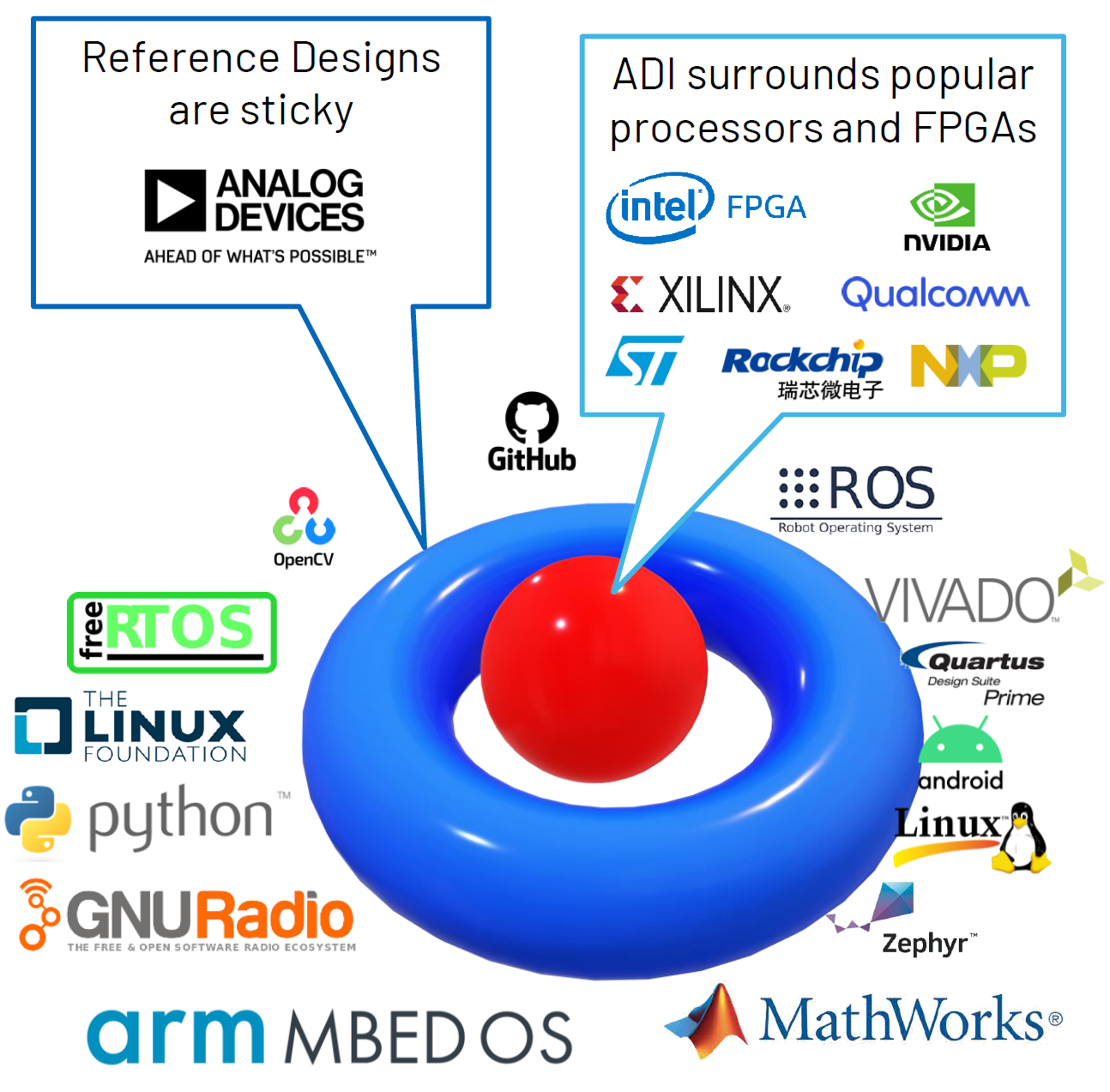
COS Full Stack High Level Overview
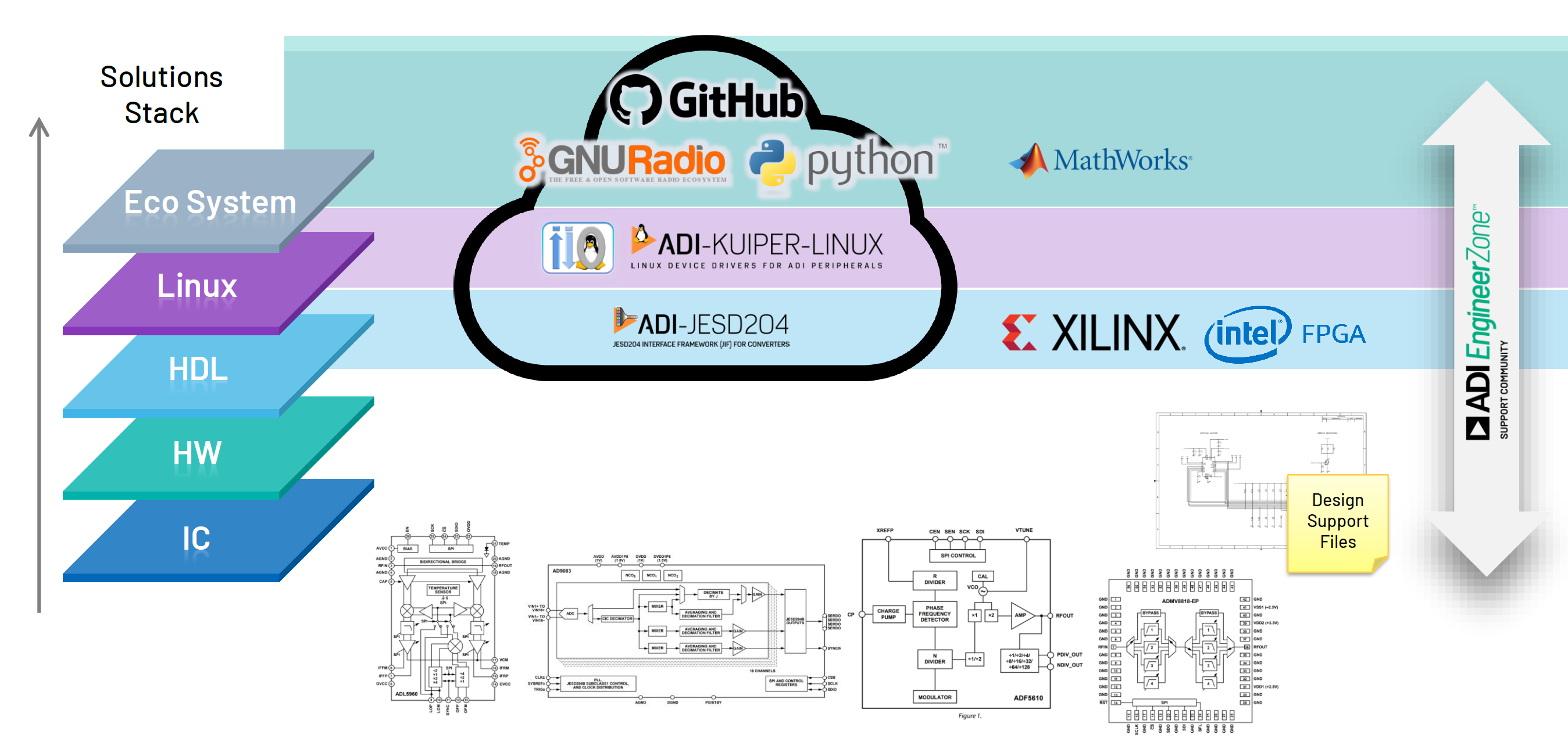
COS Full Stack HDL Designs
Common HDL across all IIO reference designs
Full stack reference Designs include JESD204 physical layers (XCVR), link layers, and transport layers.
Termination to DMA via an AXI-STREAM or FIFO interface
Runs across different Intel and Xilinx carriers
Are designed to be disconnected to “insert custom signal processing”
Your modem, your signals intelligence, etc.
Example designs show how to use MUX in different places in design, to stream debug data (I/Q samples, or payload (data buffers)) as IIO streams.
Works with industry standard debug tools:
Xilinx Integrated Logic Analyzer
Intel Signal Tap
MathWorks HDL Verifier (in SoC Blockset)
COS Typical Prototyping System
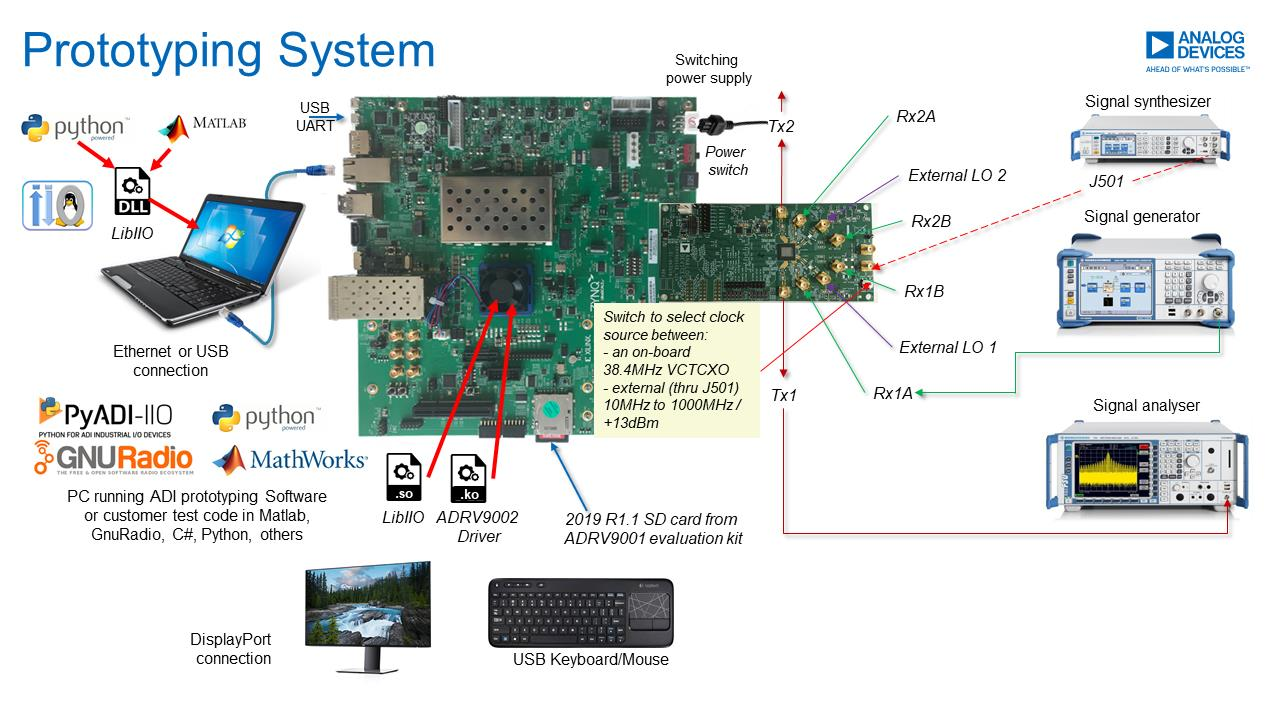
COS IP Library
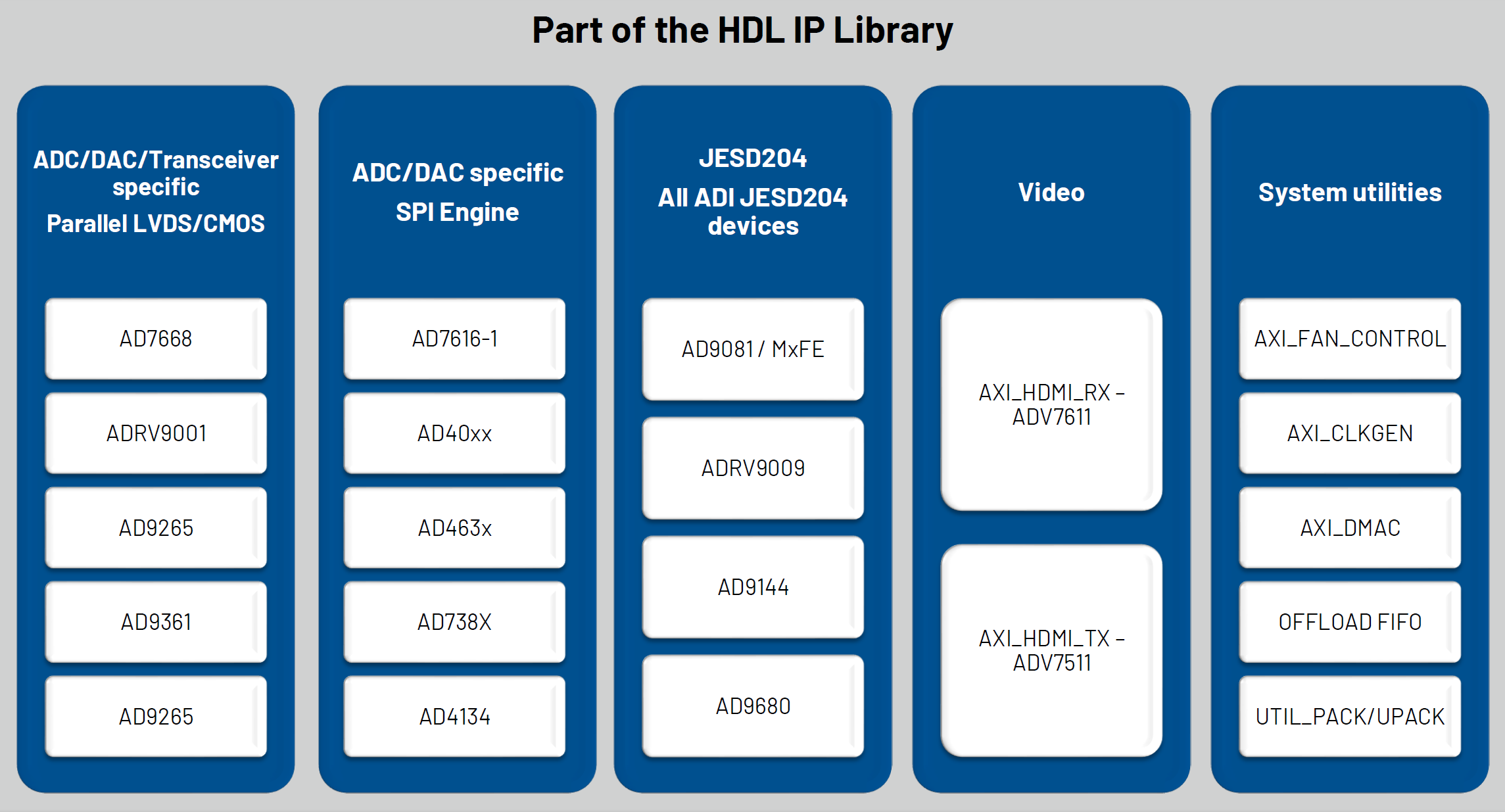
COS Frameworks - JESD204 Interface Framework
JESD204 Layers:
Physical – FPGA specific (GTXE2, GTHE3, GTHE4, GTY4, GTY5, Arria 10, Stratix 10)
Data Link – GPL 2 and commercial license
Transport – ADC/DAC/Transceiver specific
The Framework includes:
Evaluation boards
HDL
Software
COS Frameworks - SPI Engine Framework
COS HDL projects |
% |
|---|---|
JESD PROJECTS |
34% |
SPI ENGINE PROJECTS |
21% |
CUSTOM INTERFACE PROJECTS |
45% |
SPI Engine supports 21.5% of the HLD projects.
SPI Engine Architecture
Serial Peripheral Interface
A full-duplex serial communication bus design by Motorola in mid 1980s, used in short distance chip to chip communication, primarily in embedded systems. It becomes a ‘de facto’ standard, with small variations depending on the use case and application.
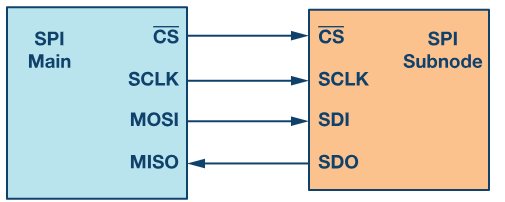
SCLK – Serial Clock from master MOSI – Master Output Slave Input MISO – Master Input Slave Output CSN – Chip Select N (active low)
SPI MODE |
CPOL |
CPHA |
|---|---|---|
0 |
0 |
0 |
1 |
0 |
1 |
2 |
1 |
0 |
3 |
1 |
1 |
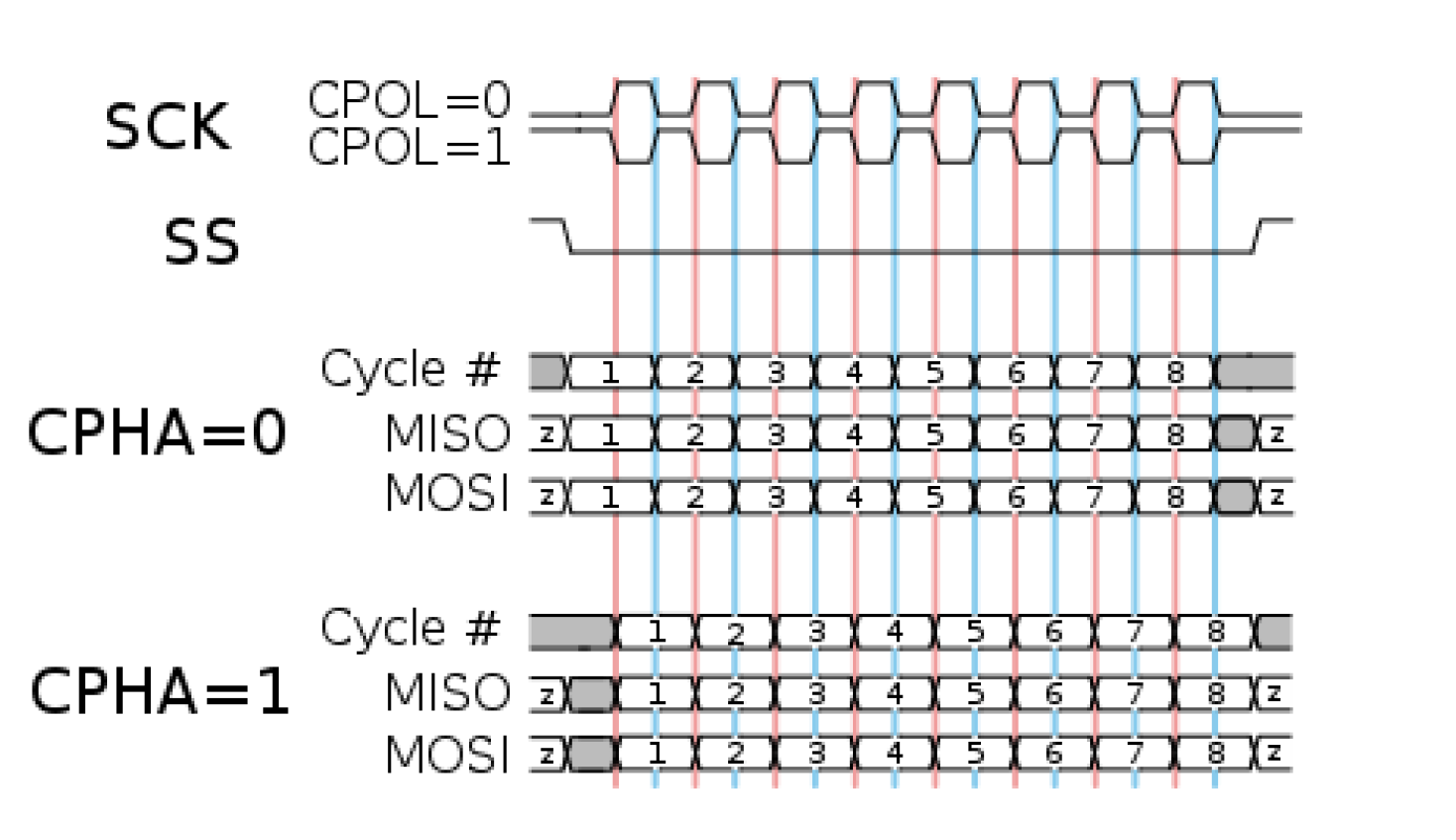
Why the MCU SPI controller isn’t enough?
Physical layer challenges:
Almost every ADI chip has a 3-wire SPI (but this is not a big issue)
CS can have other functionalities too (e.g., conversion start)
Other status or control lines can co-exist (BUSY/CNV)
Multiple MOSI line can co-exist
SCLK frequency limited to ~50MHz (higher frequency support is rear)
Fixed timing relationship of the interface lines
No possibility to synchronize the interface with other signals
Limited number of MISO lines
No DDR support
All the SPI controllers are fully software driven:
Can not support low latency transfers
Can not support high throughput periodic transfers (capture or send a stream of data)
Non-deterministic (e.g., time between spi_read function call and the actual SPI transfer is undefined)
SPI transfers timing diagram – AD4020
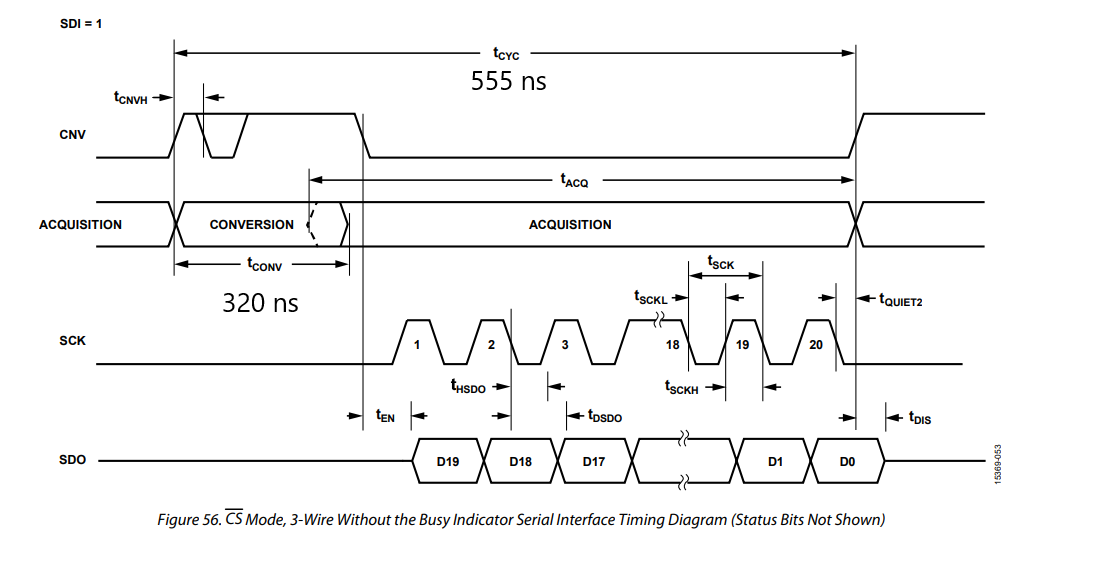
SPI transfers timing diagram – AD4630
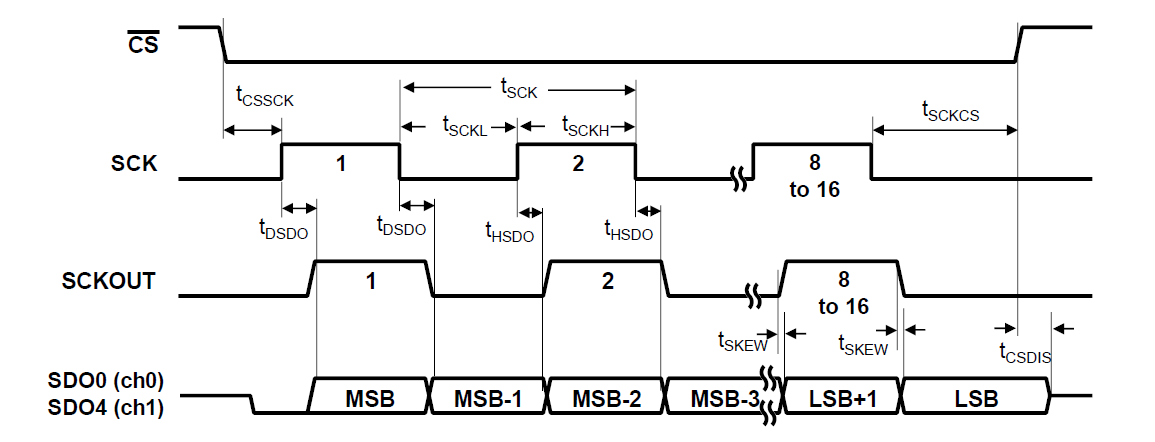
SPI Engine Framework – What it is?
SPI Engine is a highly flexible and powerful SPI controller open-source framework. It consists out of multiple submodules which communicate over well-defined interfaces. This allows a high degree of flexibility and re-usability while at the same time staying highly customizable and easily extensible.
Some of the SPI Engine Framework features are:
HDL IP supporting the two major FPGA vendors (AMD Xilinx and Intel)
Software API integrated into the Linux kernel’s SPI framework
Bare-metal software API
Examples with various devices (device drivers that leverage the framework)
SPI Engine Framework – HDL Architecture
Command Stream Generator (CSG)
Software driven (controlled through a register map)
Hardware driven (MISO or MOSI data offload)
Generate a predefined command sequence periodically or synchronously
Command Stream Executor (CSE)
Parse an incoming command stream and drive the physical pins on the interface
Can be a standard parser or a custom parser (e.g. custom SDI latching)
Command Stream Interconnect (CSI)
Arbitrates multiple streams from multiple CSGs to a single CSE
SPI Engine Framework – AXI SPI Engine IP
Memory mapped access to command stream interface
Fully software controlled CSG
Memory mapped access to offload control interface
Allow dynamic reconfiguration of offload block
SPI clock and AXI clock can be asynchronous
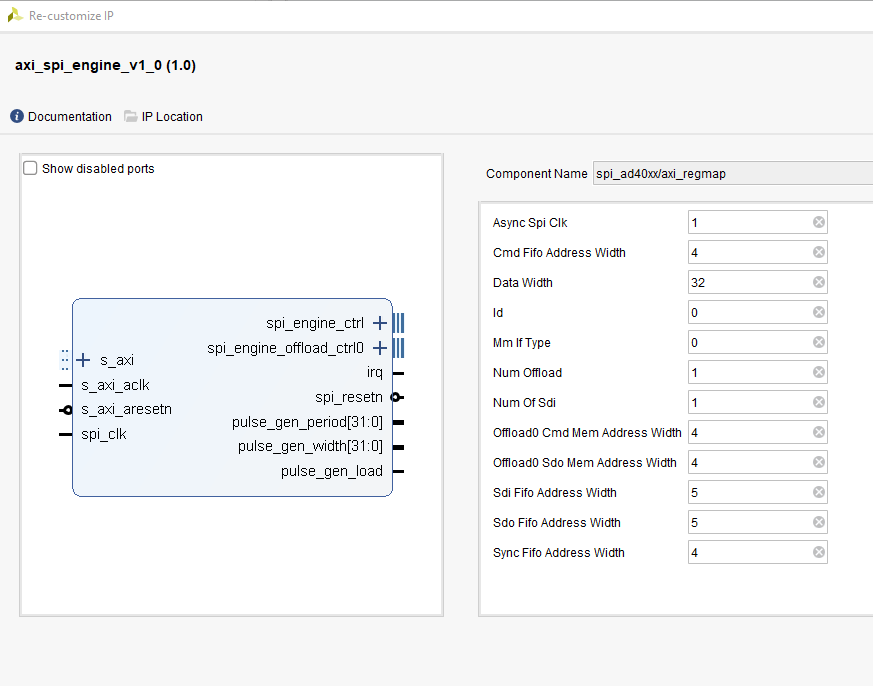
SPI Engine Framework – Data Offload IP
Internal RAM/ROM for CMD and SDO stream
A trigger launches a command stream
Received data is sent to an AXI4-streaming interface
It can be connected directly to a DMA
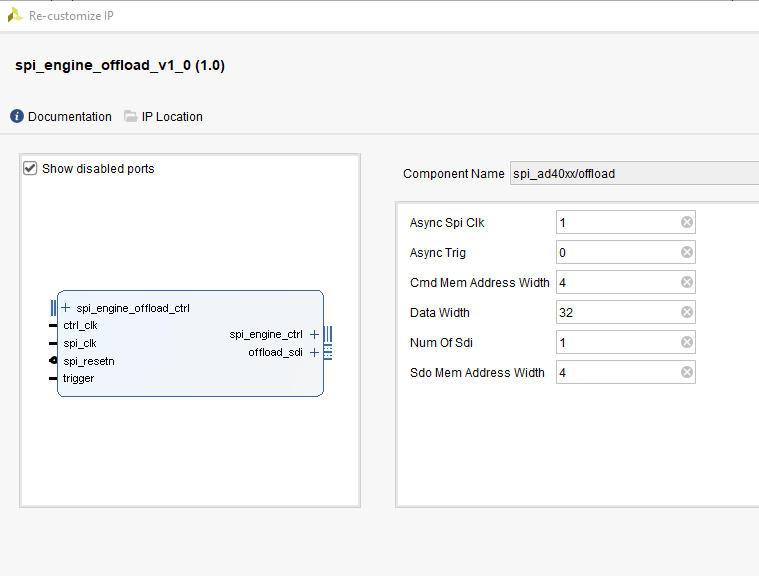
SPI Engine Framework – Interconnect IP
Arbitrates multiple command streams into a single CSE
Arbitration is done at an SPI transaction level (a SYNC instruction must be used for end of transaction)
Lower slave port always take precedence
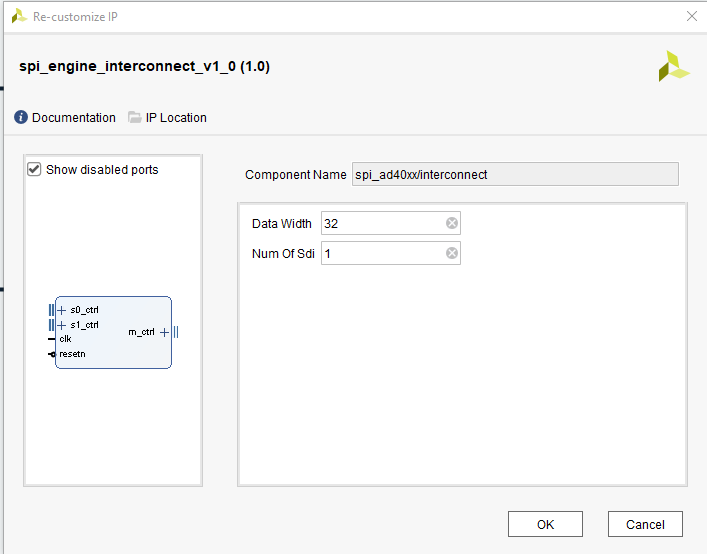
SPI Engine Framework – Execution IP
Accepts commands on the control interface
Generates low-level SPI signals on the SPI interface
Active signal indicates if the block is busy processing commands
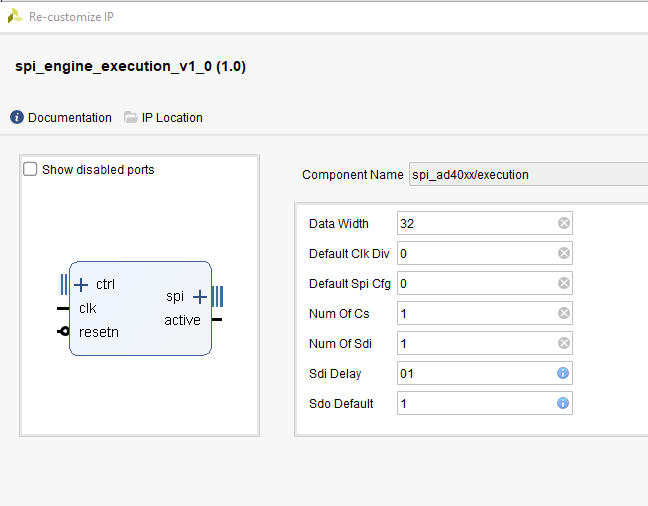
SPI Engine Framework – Command Stream Interfaces
4 AXI-Stream interfaces
CMD: Instructions
SDO: SPI write data (MOSI)
SDI: SPI read data (MISO)
SYNC: Synchronization events
Each streams follows standard AXI-Stream handshaking
Only the main AXI-stream signals are used (ready, valid, data)
SPI Engine Framework – Software support
Introduces the concept of SPI offload
Moves certain operations typically performed by the application processor to the SPI controller
Interrupt offload capability
Data offload capability
SPI-Engine is one implementation of SPI offload
ADI converter drivers can be used with any offload capable SPI controller
Build prerequisites – HDL repository
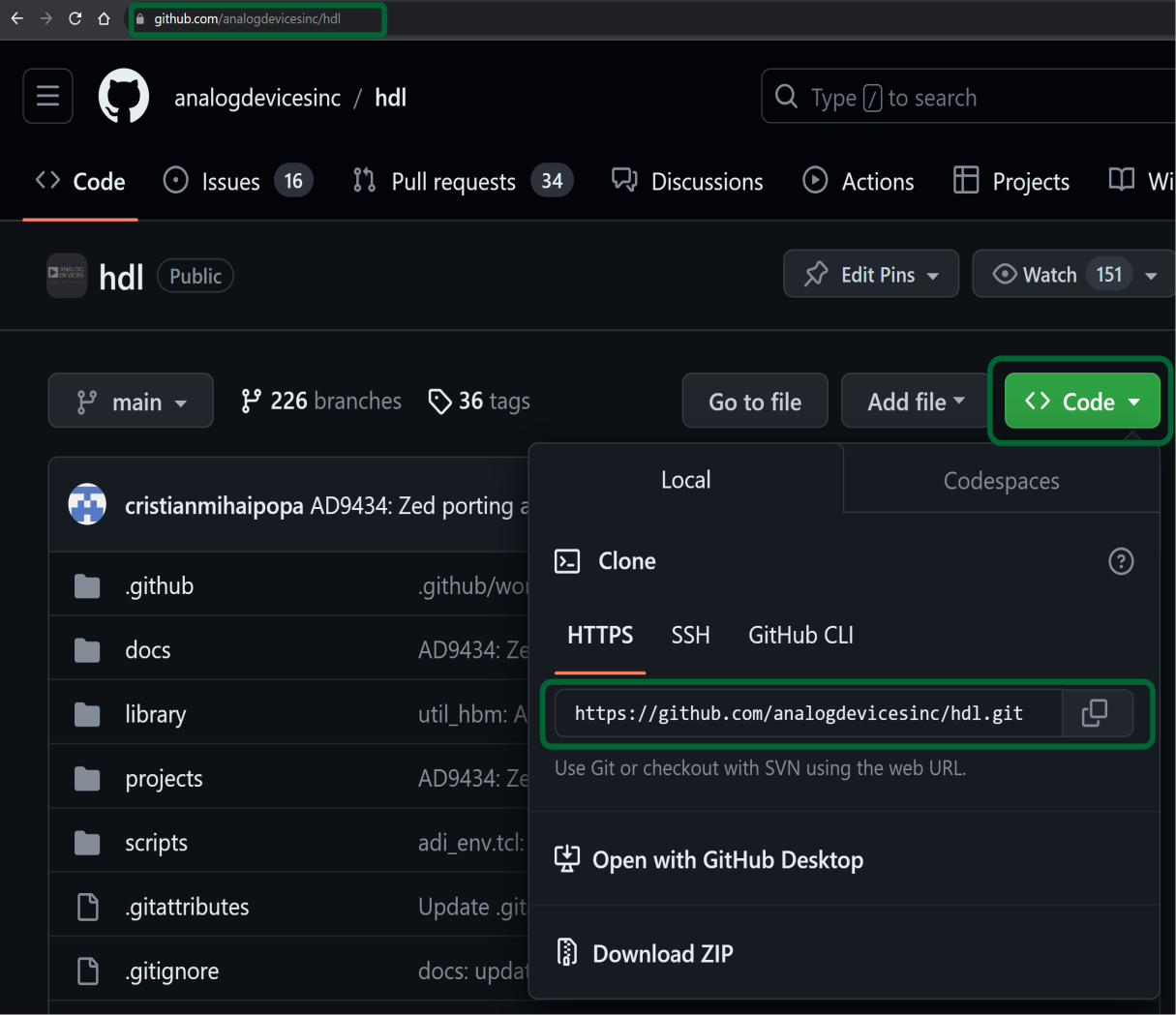
Build prerequisites – Linux repository
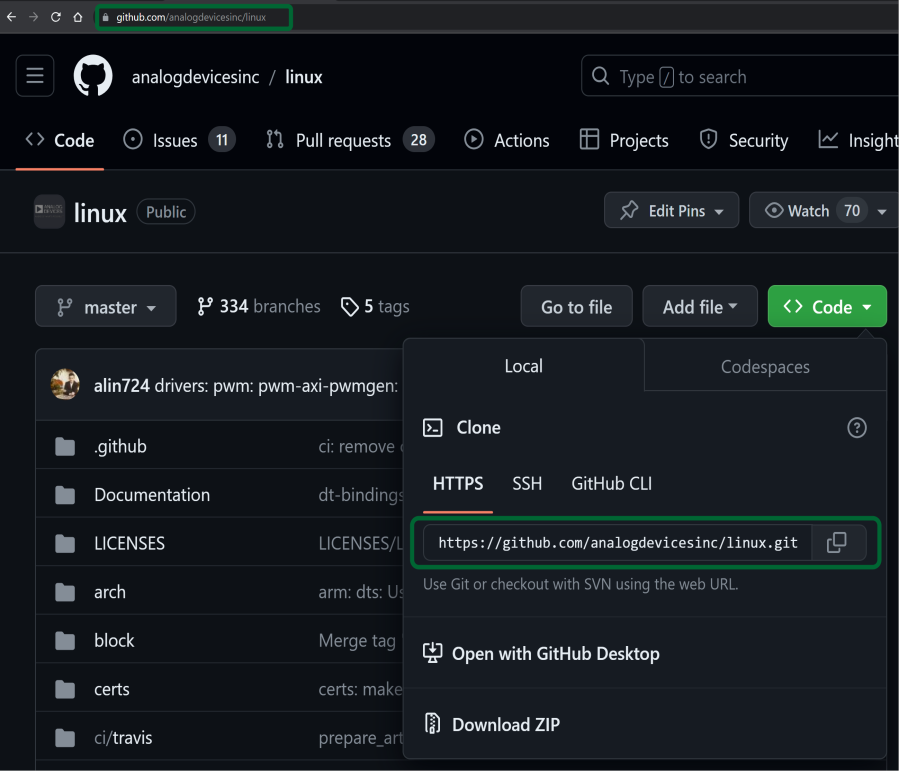

Use Case
What is the use case?

Requirements:
Highest sampling rate possible with low jitter in sample acquisition
Maximum SNR
Minimum THD
Minimize processor usage for data acquisition and processing
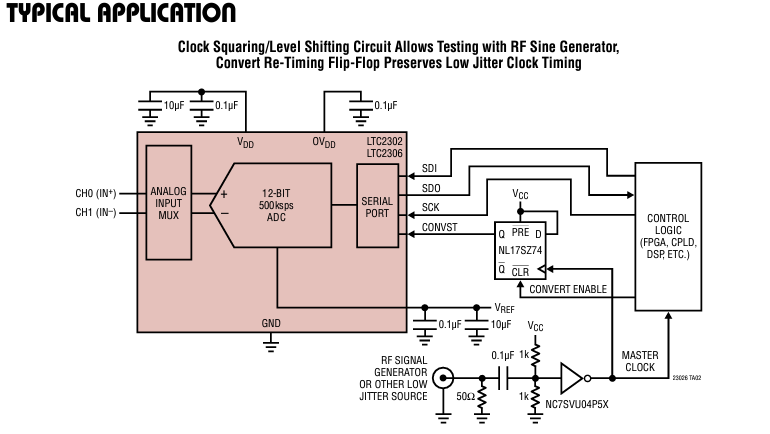
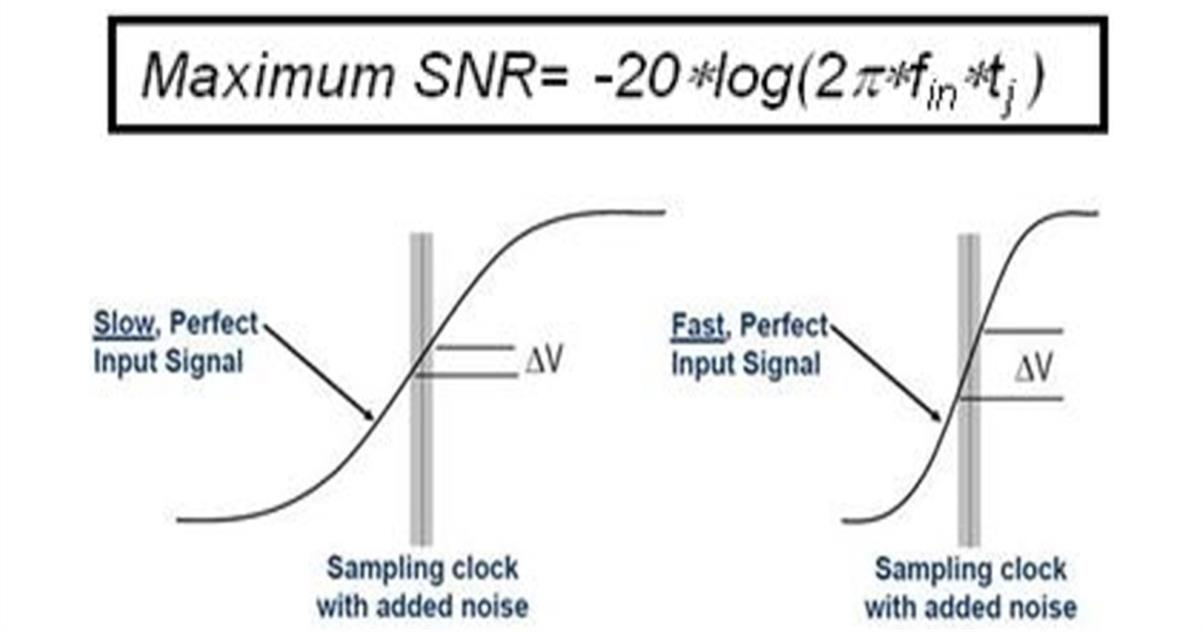

Test conditions |
Regular SPI controller |
SPI Engine controller |
|---|---|---|
Resolution[bits] |
16 |
18 |
Sampling rate[KSPS] |
15 |
15 and 1330 |
Input signal frequency[kHz] |
1 |
1 |
Input signal amplitude[dBFS] |
-0.5 |
-0.5 |
Supply voltage [V] |
-2.5 and 5 |
-2.5 and 5 |
Features of the AD7984 converter
High performance
Throughput: 1.33 MSPS
True differential analog input range: ±VREF
0 V to VREF with VREF between 2.9 V to 5 V
Zero latency architecture
18-bit resolution with no missing codes
Dynamic range: 99.7 dB, VREF = 5 V
SNR: 98.5 dB at fIN = 1 kHz, VREF = 5 V
THD: −110.5 dB at fIN = 1 kHz, VREF = 5 V
SINAD: 97.5 dB at fIN = 1 kHz, VREF = 5 V
AD7984 SPI transfer Timing Diagram
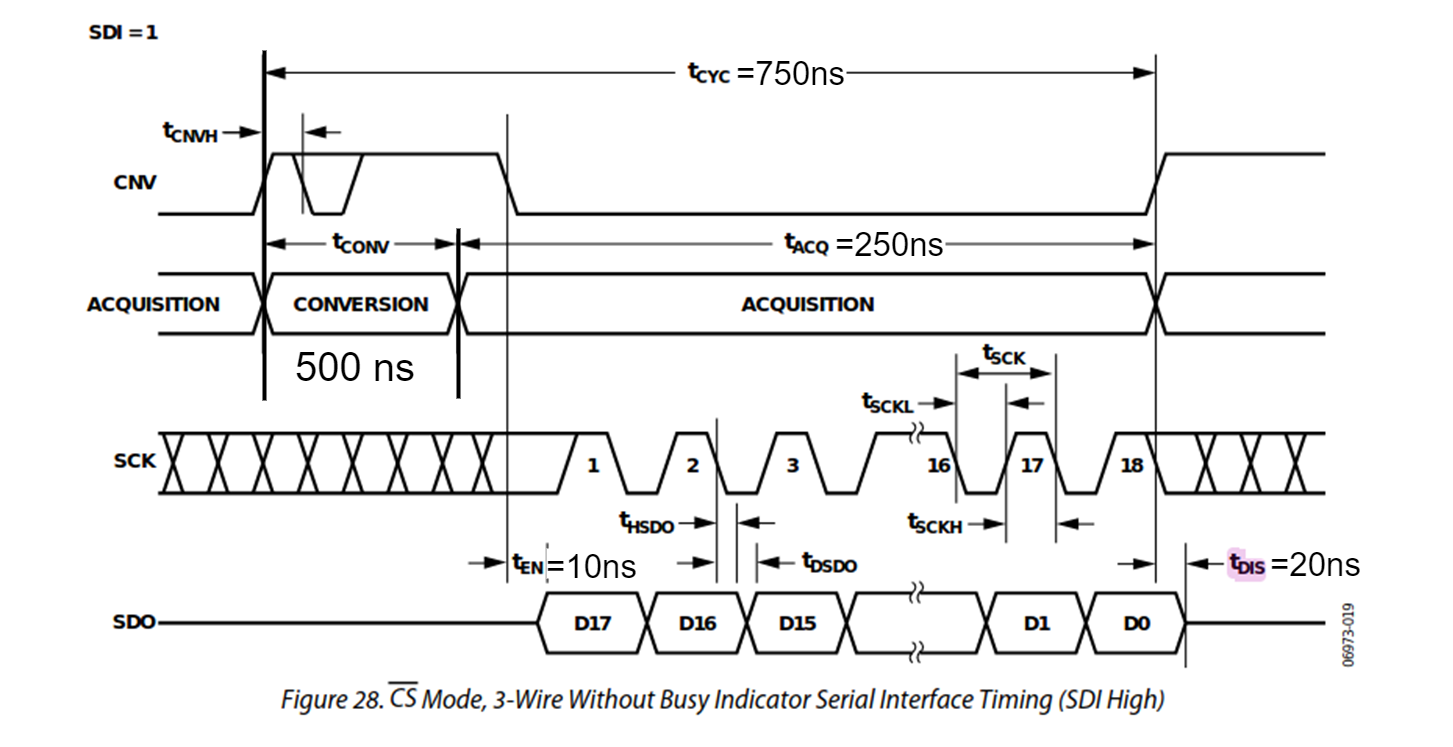
Timing parameters needed to configure the framework
Device |
Resolution [bits] |
Sample rate [KSPS] |
T_SPI_SCLK min [ns] |
T_CONV max [ns] |
T_CYC min [ns] |
T_ACQ min [ns] |
|---|---|---|---|---|---|---|
AD7942 |
14 |
250 |
18 |
2200 |
4000 |
1800 |
AD7946 |
14 |
500 |
15 |
1600 |
2000 |
400 |
AD7988-1 |
16 |
100 |
12 |
9500 |
1000 |
500 |
AD7685 |
16 |
250 |
15 |
2200 |
4000 |
1800 |
AD7687 |
16 |
250 |
10 |
2200 |
4000 |
1800 |
AD7691 |
16 |
250 |
15 |
2200 |
4000 |
1800 |
AD7686 |
16 |
500 |
15 |
1600 |
2000 |
400 |
AD7693 |
16 |
500 |
15 |
1600 |
2000 |
400 |
AD7988-5(B) |
16 |
500 |
12 |
1600 |
2000 |
400 |
AD7988-5(C) |
16 |
500 |
12 |
1200 |
2000 |
800 |
AD7980 |
16 |
1000 |
10 |
710 |
1000 |
290 |
AD7983 |
16 |
1333 |
12 |
500 |
750 |
250 |
AD7982 |
18 |
1000 |
12 |
710 |
1000 |
290 |
AD7982 |
18 |
1000 |
12 |
710 |
1000 |
290 |
AD7984 |
18 |
1333 |
12 |
500 |
750 |
250 |
HDL design block diagram
HDL Framework instantiation
TCL Function header:
proc spi_engine_create {{name "spi_engine"} {data_width 32} {async_spi_clk 1} {num_cs 1} {num_sdi 1} {sdi_delay 0} {echo_sclk 0}}
Instantiation example for PulSAR ADC:
source $ad_hdl_dir/library/spi_engine/scripts/spi_engine.tcl4
set data_width32
set async_spi_clk1
set num_cs1
set num_sdi1
set sdi_delay1
set hier_spi_enginespi_pulsar_adc
spi_engine_create $hier_spi_engine $data_width $async_spi_clk $num_cs $num_sdi $sdi_delay
#. DATA_WIDTH - will set the width of the data bus / data line used by the SPI Engine to connect tothe DMA. It will also set the maximum word length for the SPI transfer. Since the Pulsar_ADC devices are all single SDI/SDO and some of them require 18bit transfers, this value will be rounded to 32bit.
#. ASYNC_SPI_CLK - will chose the reference clock for the SPI Engine. Setting this to 0 will configure the hierarchy to use the axi clock (100MHz) as the reference clock. Setting it to 1 will allow for an external reference clock (SPI_CLK).
NUM_CS - selects the number of CS lines.
NUM_SDI - selects the number of SDI lines.
#. SDI_DELAY - the latch of the SDI line can be delayed with 1, 2 or 3 SPI core clock cycle. Needed for designs with high SCLK rate (>50MHz).
PulSAR ADC Architecture

ADI AXI PWM GENERATOR
ad_ip_parameter pulsar_adc_trigger_gen CONFIG.PULSE_0_PERIOD 120
ad_ip_parameter pulsar_adc_trigger_gen CONFIG.PULSE_0_WIDTH 1
ad_connect spi_clk pulsar_adc_trigger_gen/ext_clk
ad_connect pulsar_adc_trigger_gen/pwm_0 $hier_spi_engine/offload/trigger
AXI CLKGEN
ad_ip_instance axi_clkgen spi_clkgen
ad_ip_parameter spi_clkgen CONFIG.CLK0_DIV 5
ad_ip_parameter spi_clkgen CONFIG.VCO_DIV 1
ad_ip_parameter spi_clkgen CONFIG.VCO_MUL 8
ad_connect $hier_spi_engine/m_spi pulsar_adc_spi
ad_connect spi_clk spi_clkgen/clk_0
ad_connect spi_clk spi_pulsar_adc/spi_clk
ADI AXI DMA CONTROLLER
ad_ip_parameter axi_pulsar_adc_dma CONFIG.DMA_TYPE_SRC 1
ad_ip_parameter axi_pulsar_adc_dma CONFIG.DMA_TYPE_DEST 0
ad_ip_parameter axi_pulsar_adc_dma CONFIG.CYCLIC 0
ad_ip_parameter axi_pulsar_adc_dma CONFIG.SYNC_TRANSFER_START 0
ad_ip_parameter axi_pulsar_adc_dma CONFIG.AXI_SLICE_SRC 0
ad_ip_parameter axi_pulsar_adc_dma CONFIG.AXI_SLICE_DEST 1
ad_ip_parameter axi_pulsar_adc_dma CONFIG.DMA_2D_TRANSFER 0
ad_ip_parameter axi_pulsar_adc_dma CONFIG.DMA_DATA_WIDTH_SRC 32
ad_ip_parameter axi_pulsar_adc_dma CONFIG.DMA_DATA_WIDTH _DEST 64
ad_connect spi_clk axi_pulsar_adc_dma/s_axis_aclk
Debug options – ILA
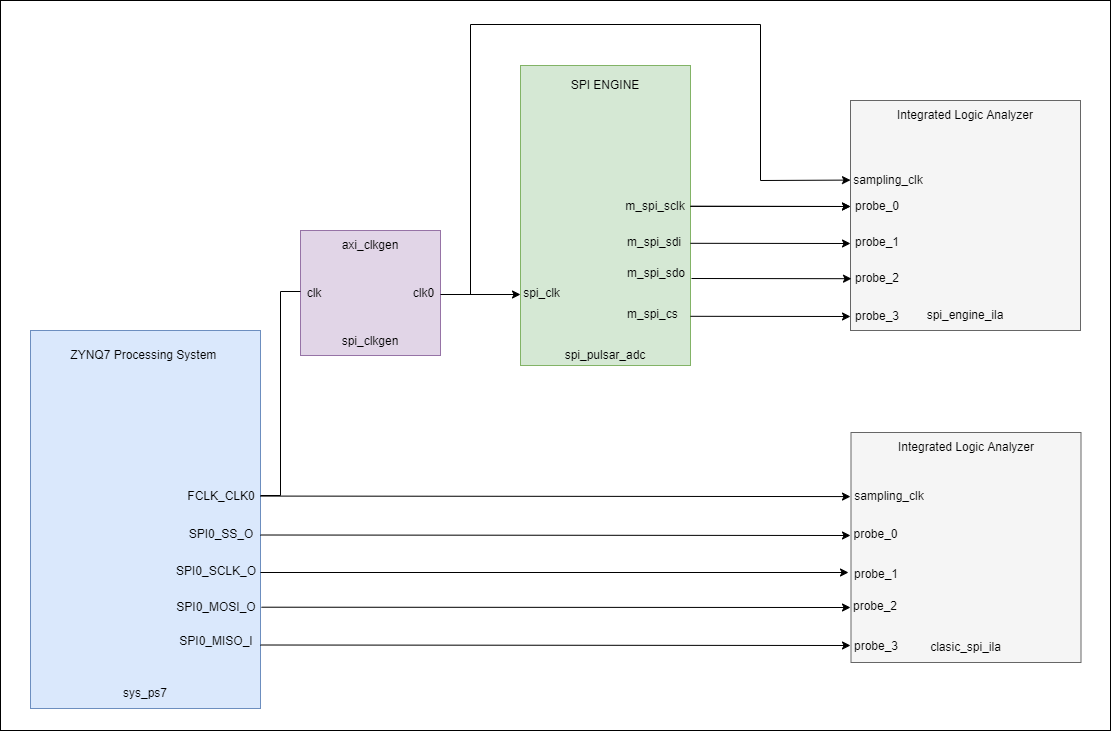
Debug options – regular SPI controller transfer capture
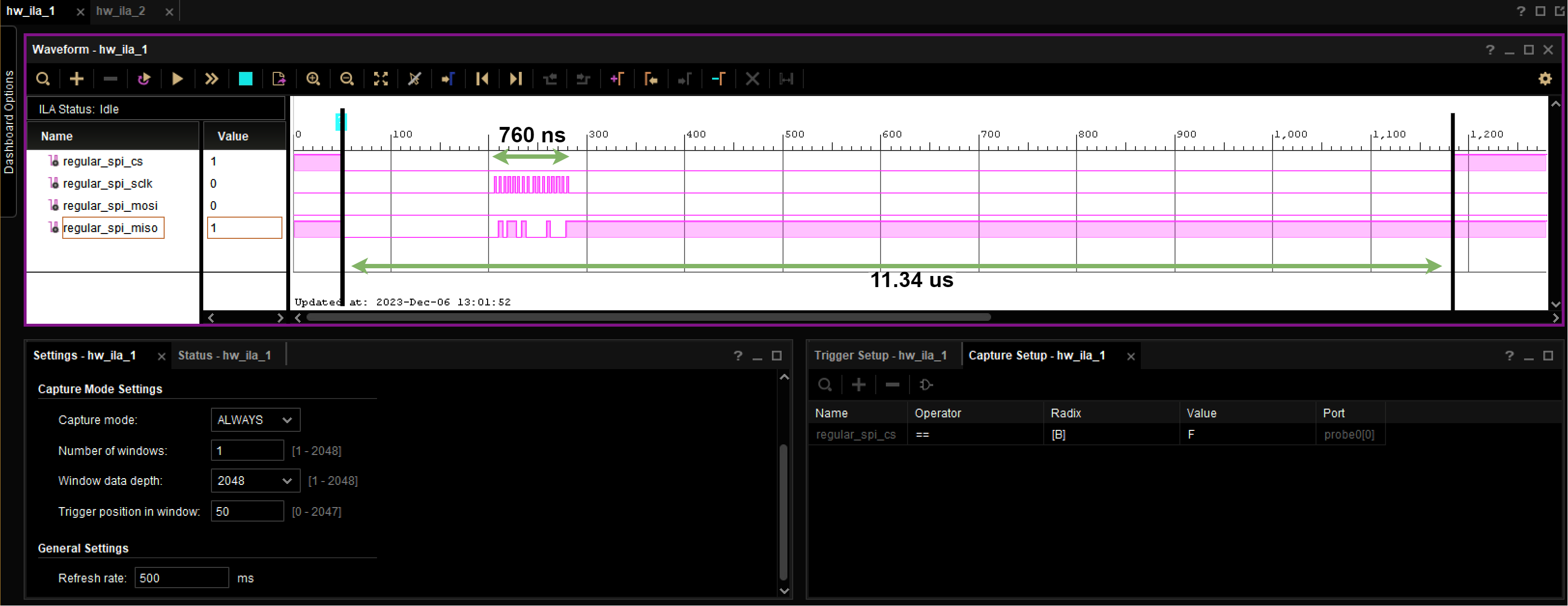
Debug options –SPI Engine controller transfer capture
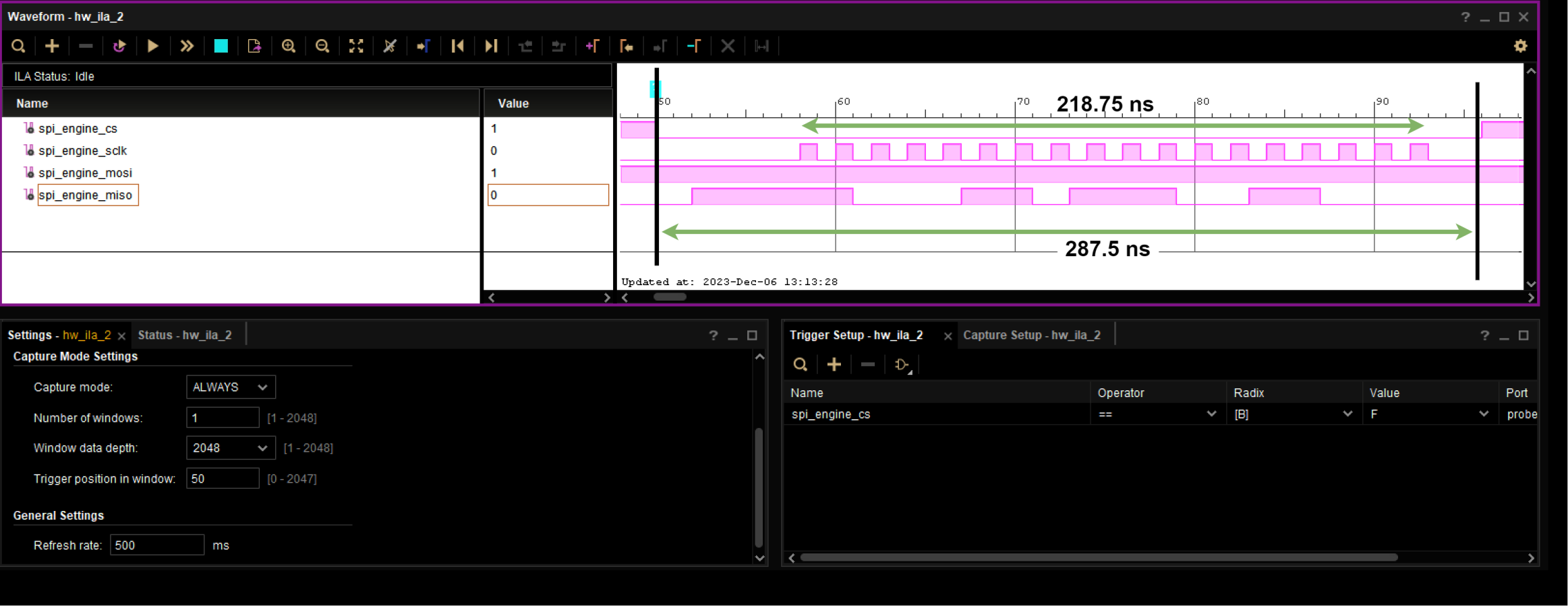
Build System
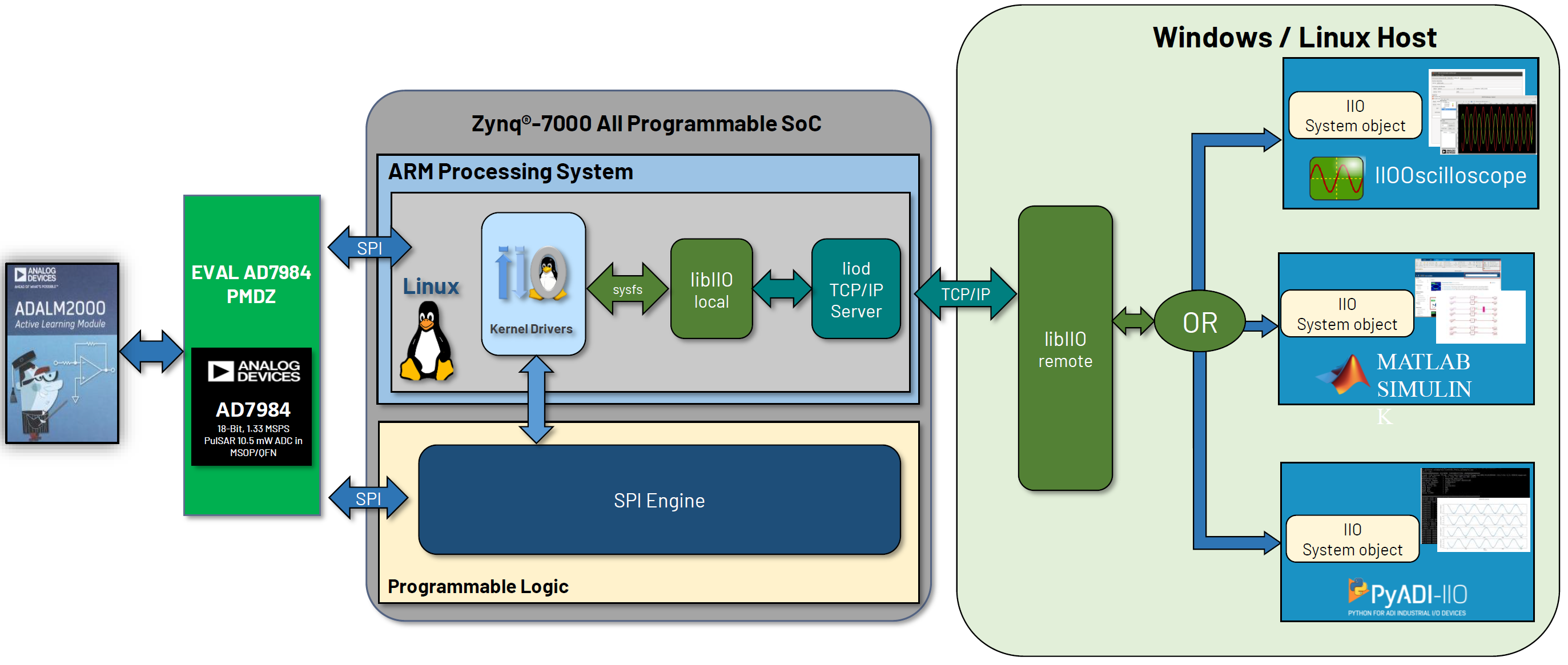
System Build - ADALM2000
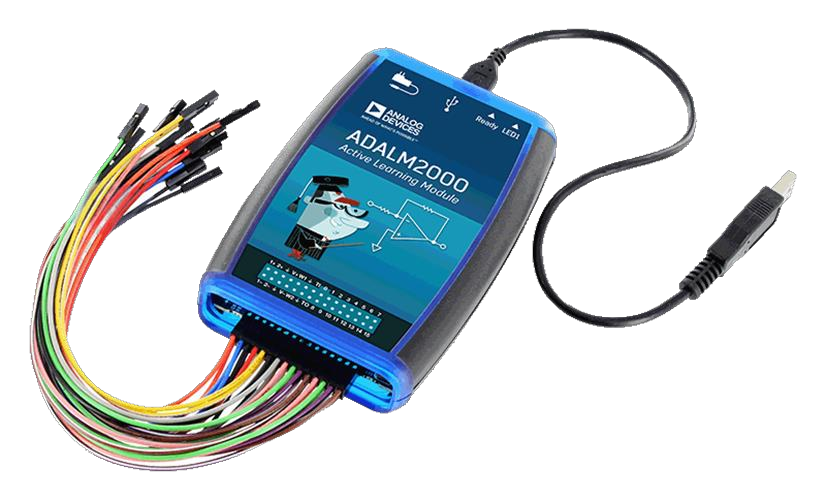
Two programmable power supplies
Two-channel USB digital oscilloscope
Two-channel arbitrary function generator
16-channel digital logic analyzer (3.3V CMOS and 1.8V or 5V tolerant, 100MS/s)
System Build - Scopy
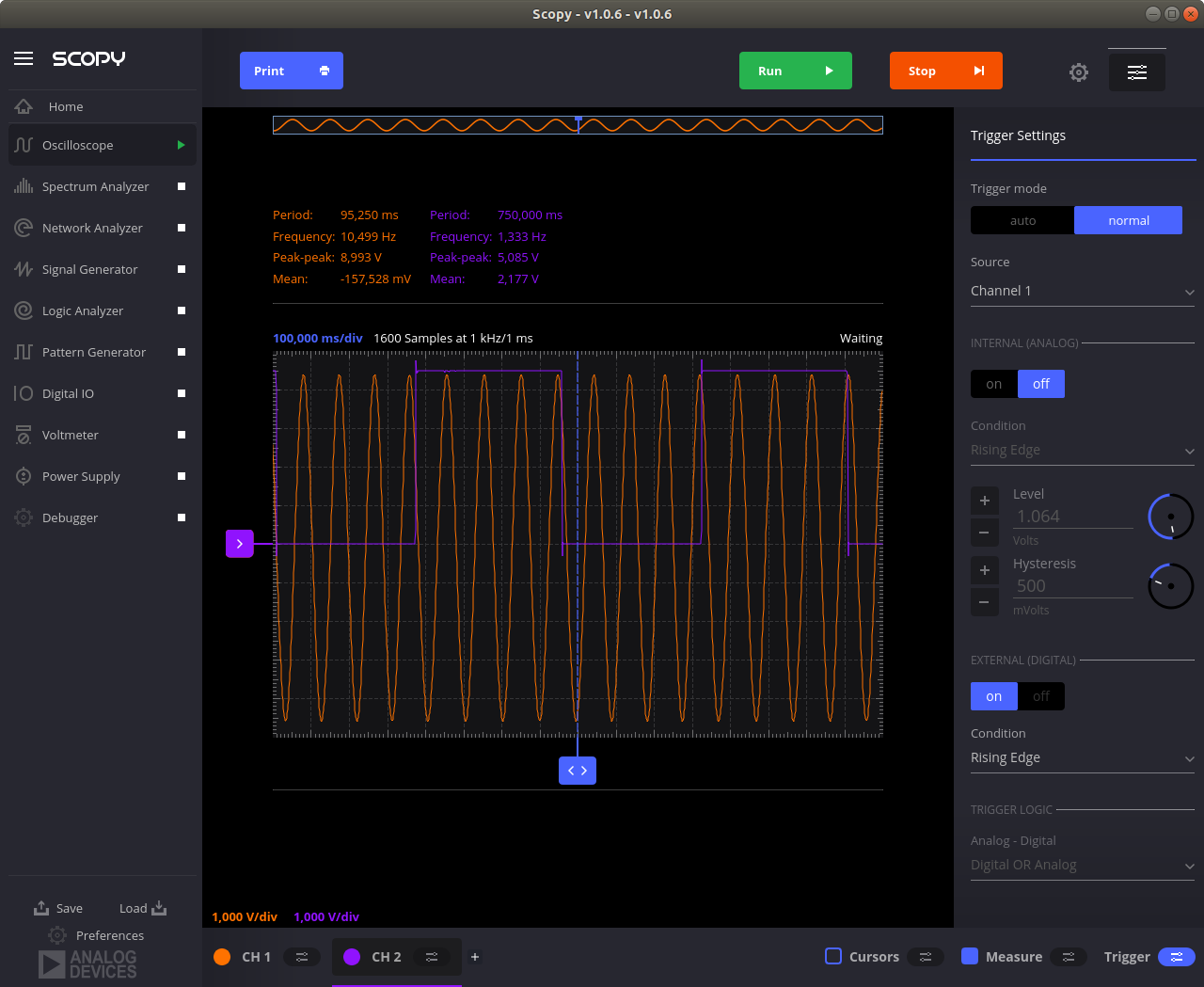
Uses the ADALM2000 to implement virtual instruments:
Oscilloscope (with Mixed Signal Capability)
Signal Generator (Functions and Arbitrary)
Spectrum Analyzer
Network Analyzer
Voltmeter
Power Supply
Logic Analyzer (with Stack Decoder support)
Digital Pattern Generator
GPIO
System Build - Schematic
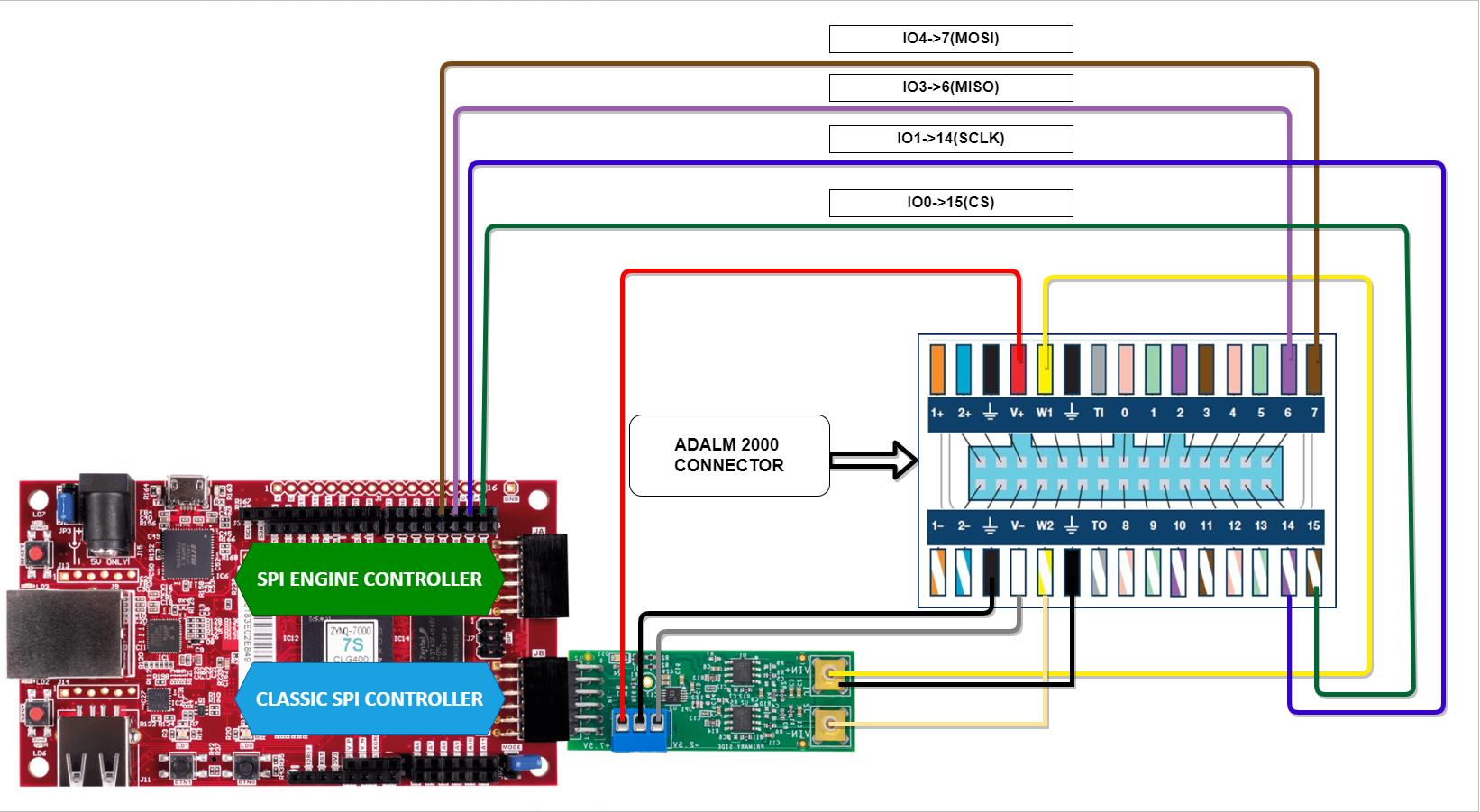
System Build - Cora Z7S Configuration
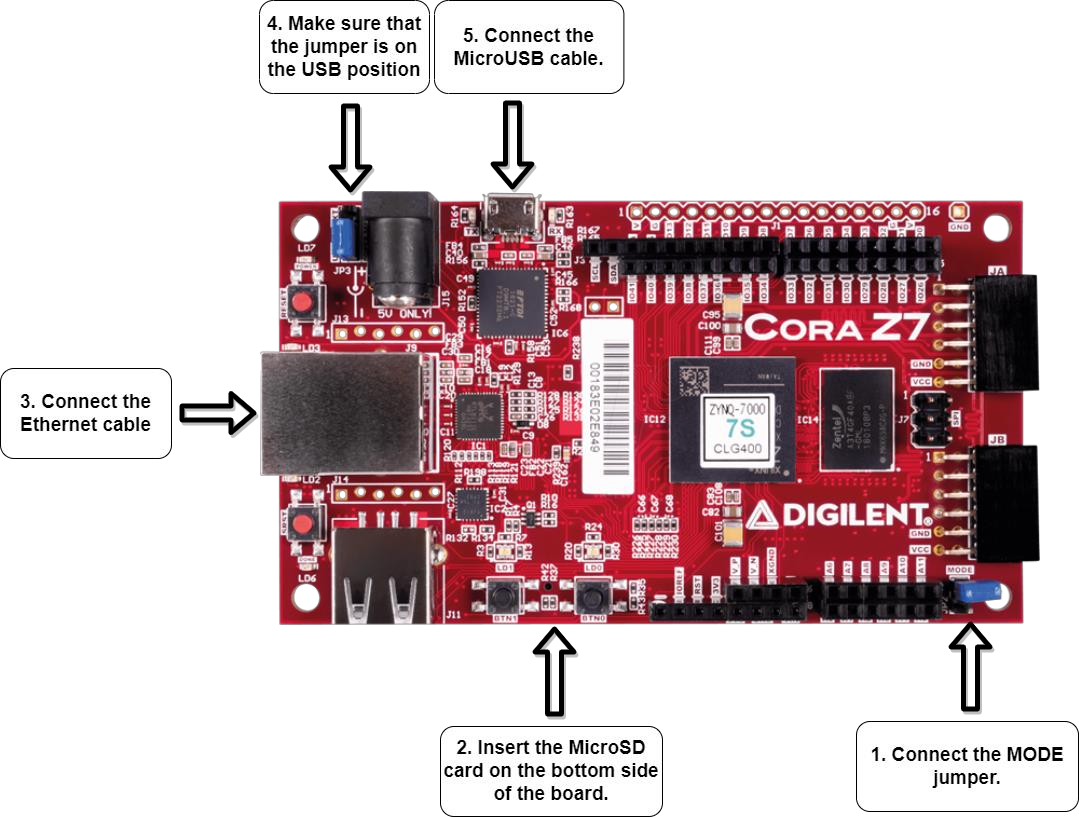
System Build - Power Supply
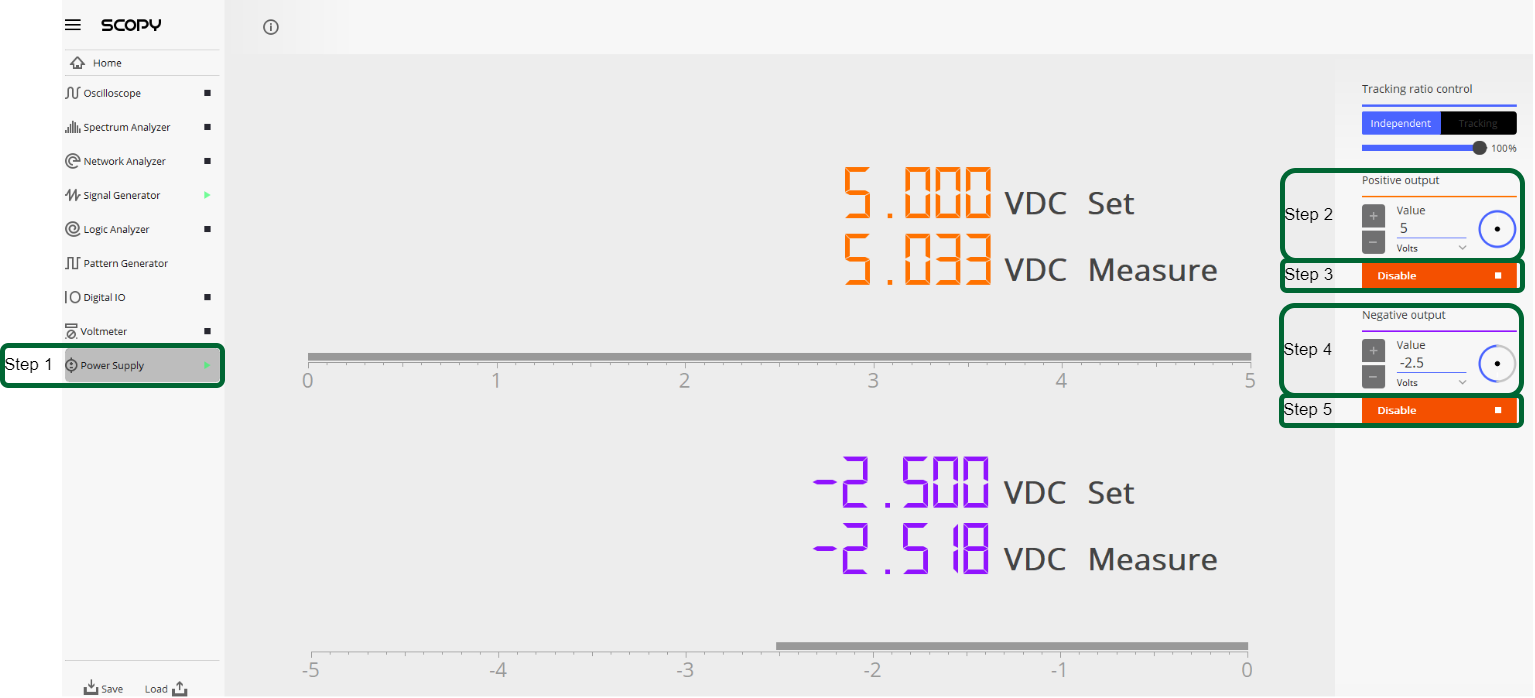
System Build - Input Signal
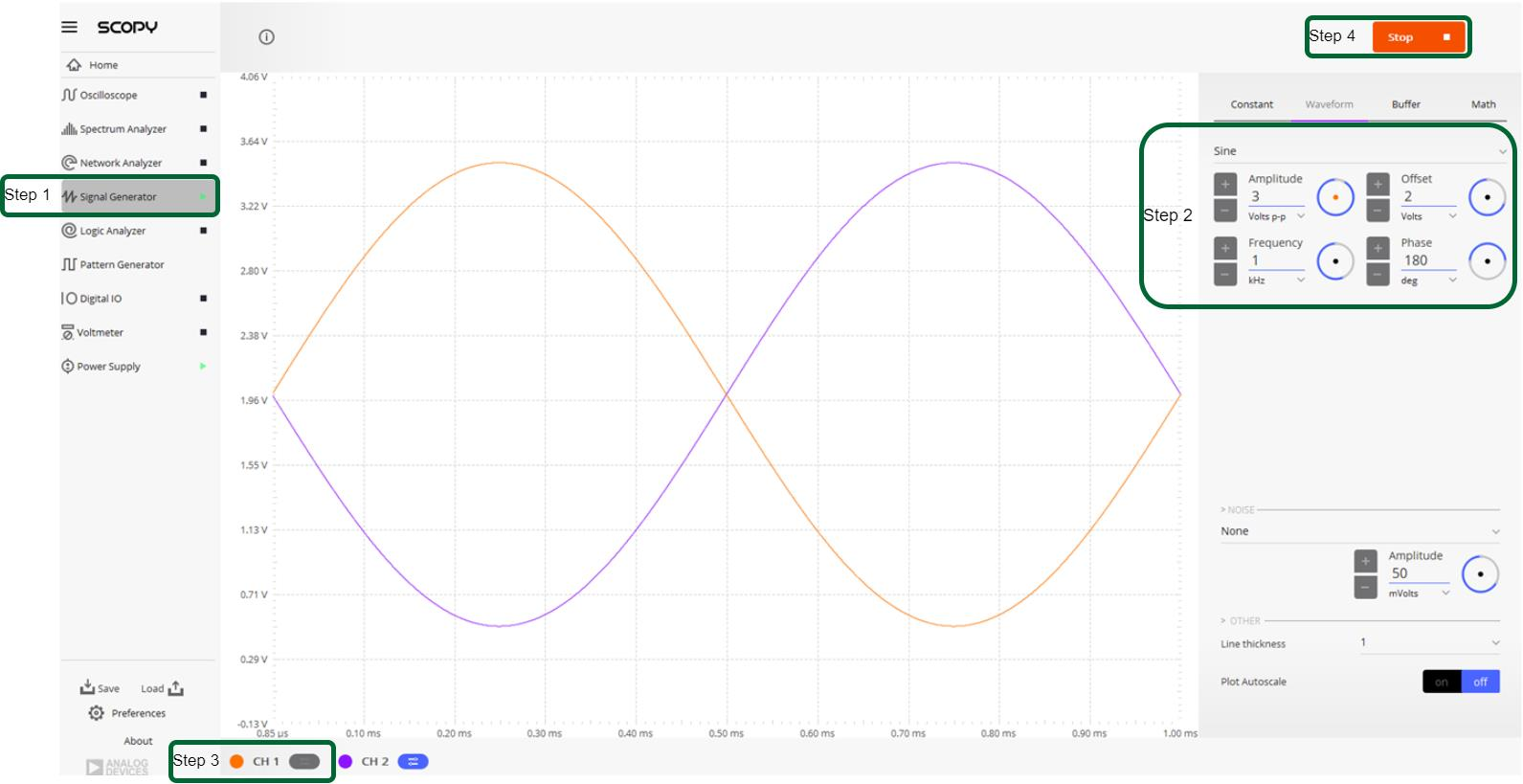
System Build - UART Configuration

System Build – change host IP
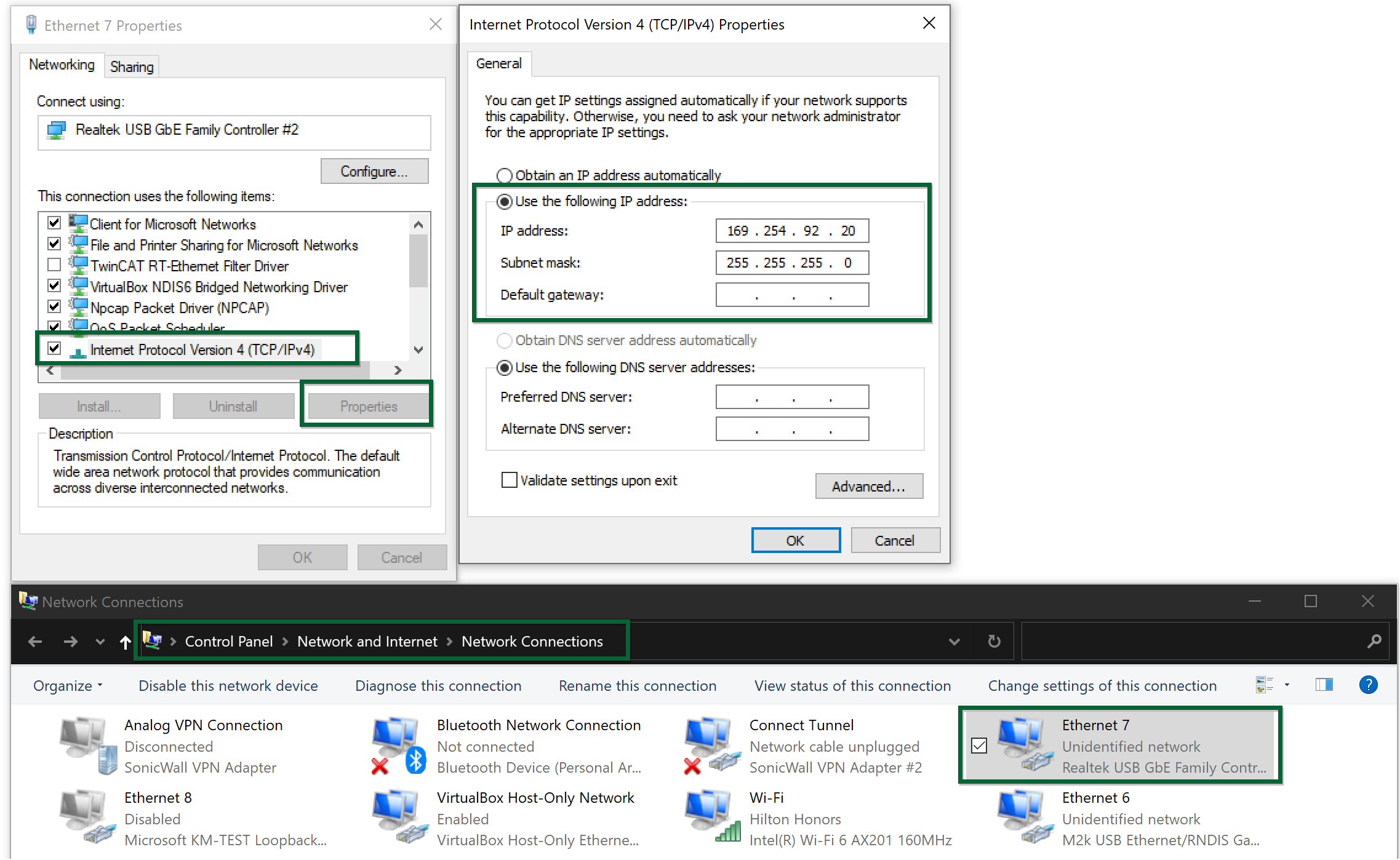
System Build - UART and Ethernet Testing
Step 1 - using Putty
~$
ifconfig
eth0: flags=4163<UP,BROADCAST,RUNNING,MULTICAST> mtu 1500
inet 169.254.92.202 netmask 255.255.255.0 broadcast 10.48.65.255
inet6 fe80::241:8f:d3d0:e43b prefixlen 64 scopeid 0x20<link>
ether 0e:23:90:e3:61:01 txqueuelen 1000 (Ethernet)
RX packets 483757 bytes 81480222 (77.7 MiB)
RX errors 0 dropped 0 overruns 0 frame 0
TX packets 5562 bytes 775511 (757.3 KiB)
TX errors 0 dropped 0 overruns 0 carrier 0 collisions 0
device interrupt 38
lo: flags=73<UP,LOOPBACK,RUNNING> mtu 65536
inet 127.0.0.1 netmask 255.0.0.0
inet6 ::1 prefixlen 128 scopeid 0x10<host>
loop txqueuelen 1000 (Local Loopback)
RX packets 83 bytes 10176 (9.9 KiB)
RX errors 0 dropped 0 overruns 0 frame 0
TX packets 83 bytes 10176 (9.9 KiB)
TX errors 0 dropped 0 overruns 0 carrier 0 collisions 0
Step 2 - using Cygwin
~$
ping 169.254.92.202
Pinging 169.254.92.202 with 32 bytes of data:
Reply from 169.254.92.202: bytes=32 time=2ms TTL=64
Reply from 169.254.92.202: bytes=32 time=1ms TTL=64
Reply from 169.254.92.202: bytes=32 time=1ms TTL=64
Reply from 169.254.92.202: bytes=32 time=1ms TTL=64
Ping statistics for 169.254.92.202:
Packets: Sent = 4, Received = 4, Lost = 0 (0% loss),
Approximate round trip times in milli-seconds:
Minimum = 1ms, Maximum = 2ms, Average = 1ms
Evaluate System
System Evaluation – regular SPI trigger configuration
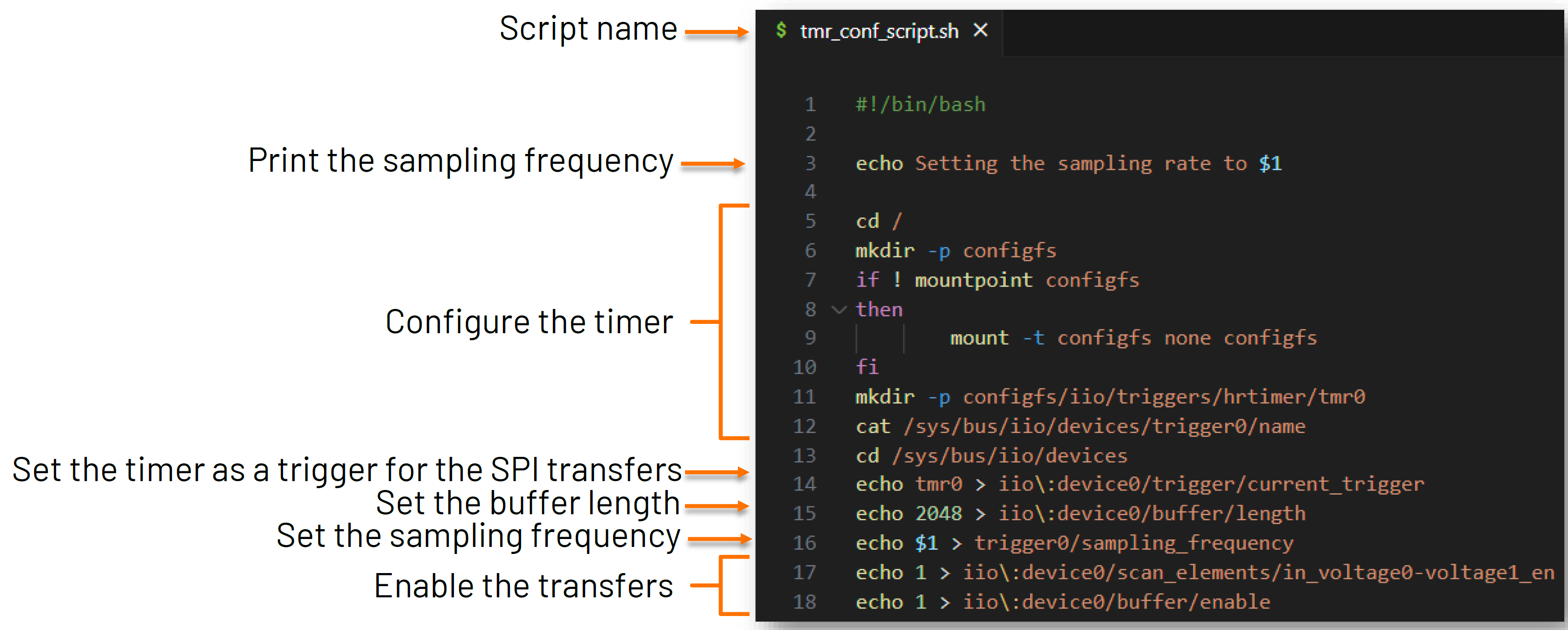

System Evaluation
Steps |
Regular SPI controller |
SPI Engine controller |
|---|---|---|
Connect IIO Oscilloscope and visualize the captured signals |
||
Run the Python script on Cora Z7S / Cygwin |
||
Analyze results in VisualAnalog |
||
Compare the results |
System Evaluation - IIO Oscilloscope


System Evaluation - Logic Analyzer
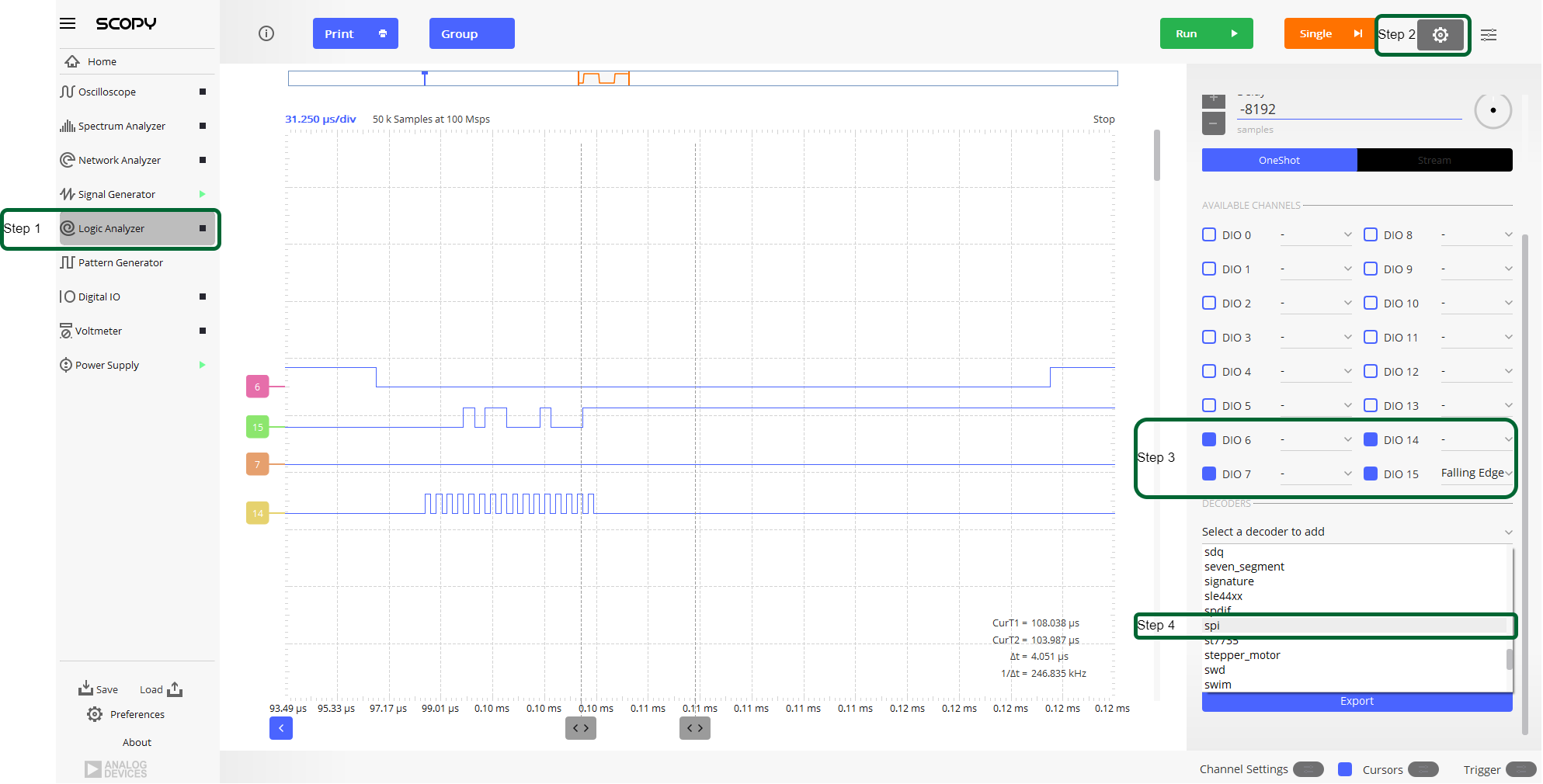
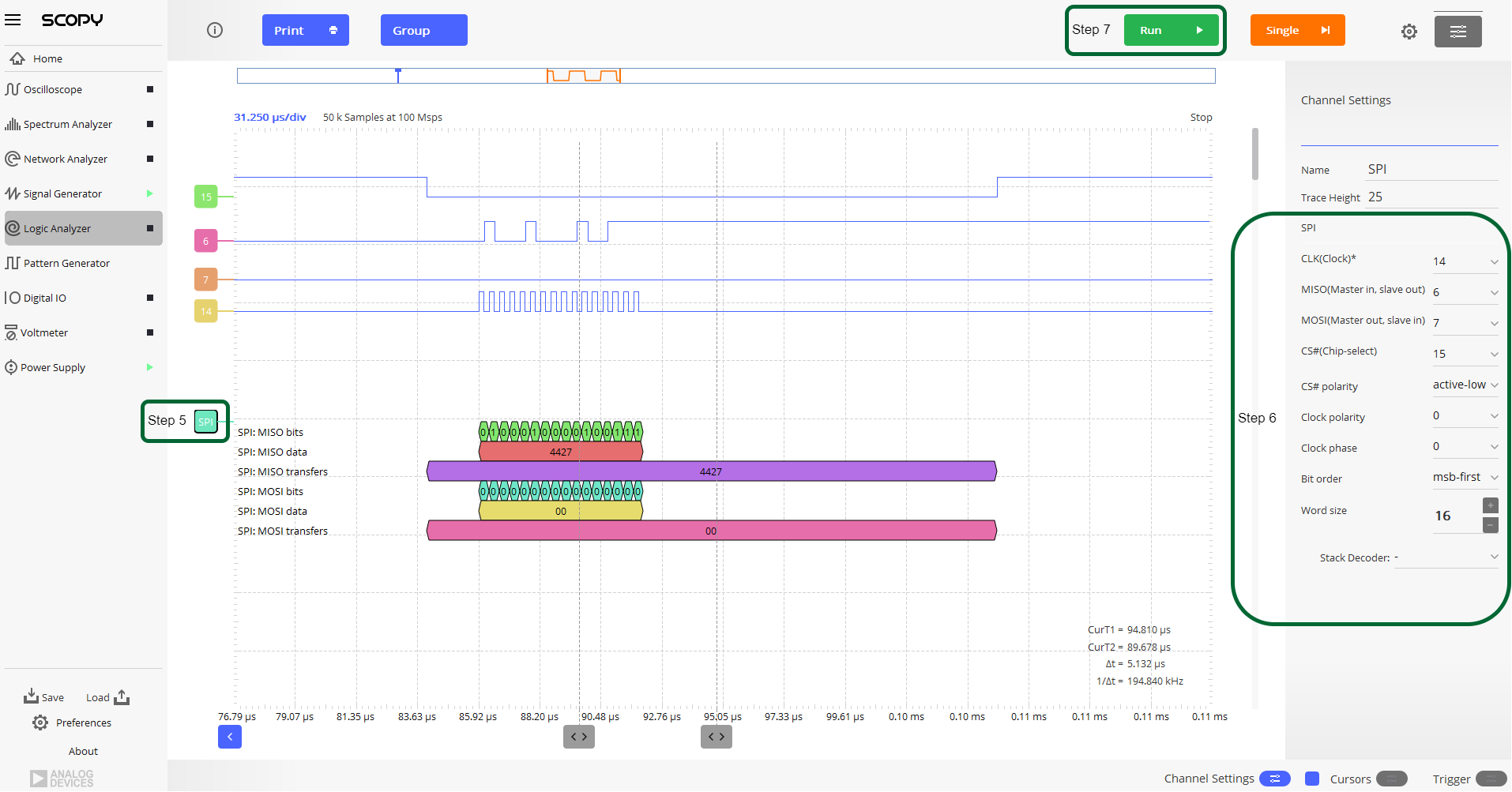
System Evaluation
Steps |
Regular SPI controller |
SPI Engine controller |
|---|---|---|
Connect IIO Oscilloscope and visualize the captured signals |
X |
|
Run the Python script on Cora Z7S / Cygwin |
||
Analyze results in VisualAnalog |
||
Compare the results |
System Evaluation - Python script
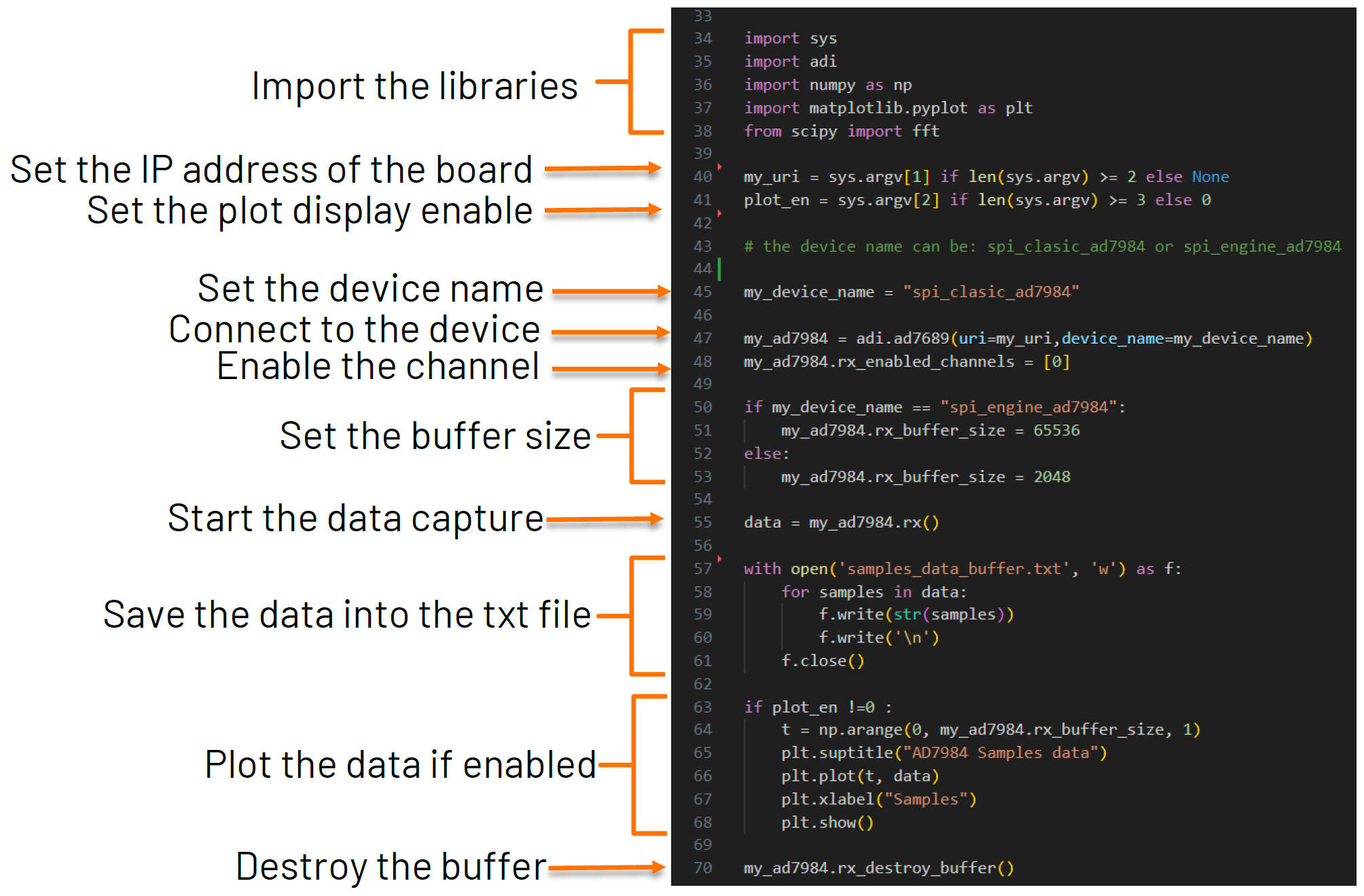
System Evaluation – Python from the FPGA board


System Evaluation – Python from a remote machine - optional
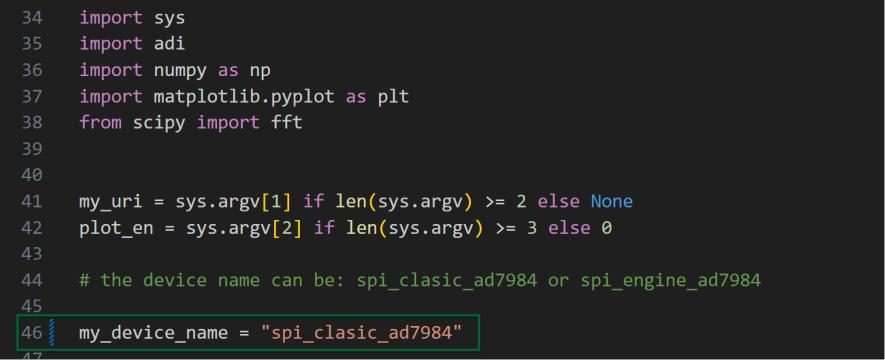

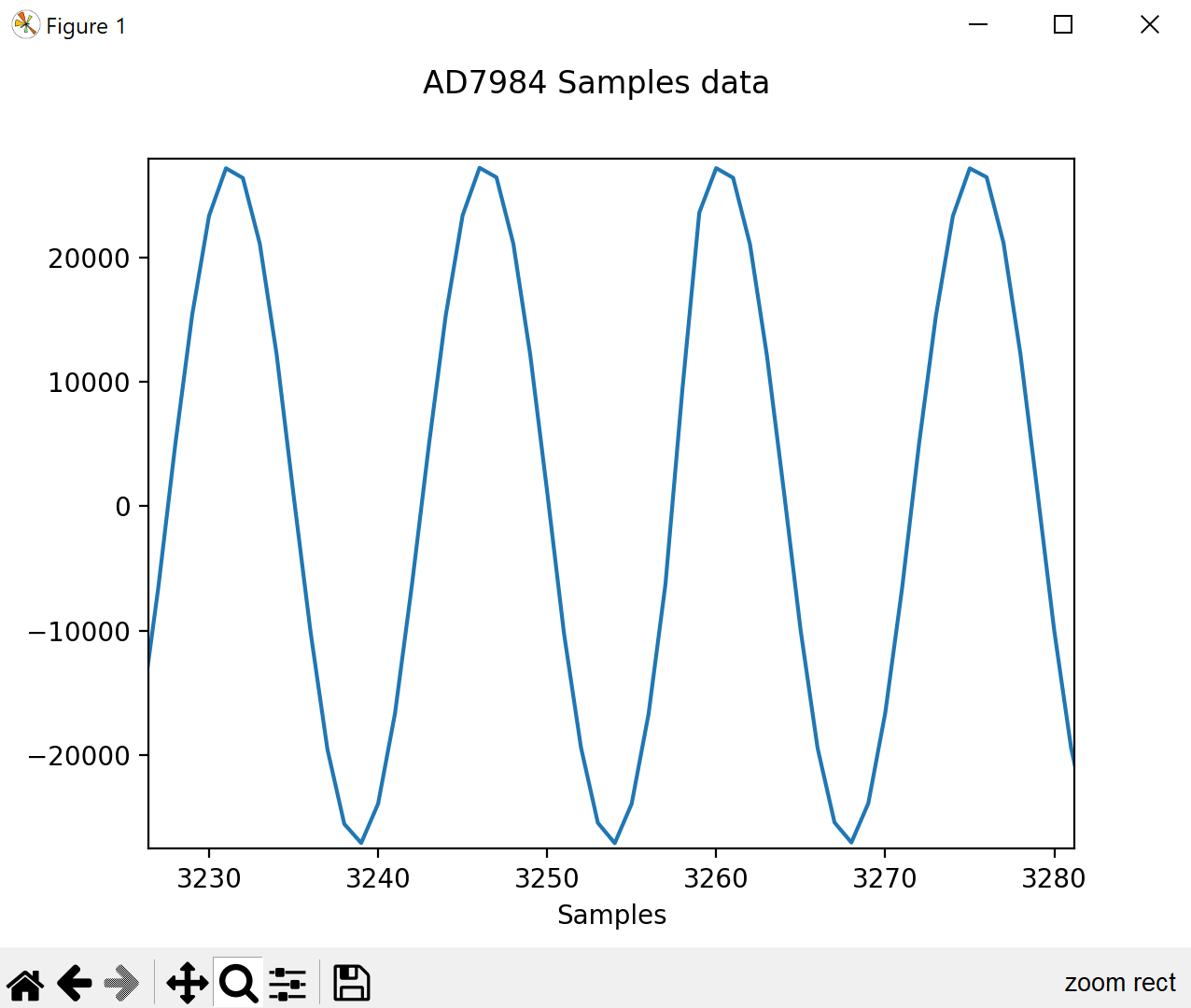
System Evaluation
Steps |
Regular SPI controller |
SPI Engine controller |
|---|---|---|
Connect IIO Oscilloscope and visualize the captured signals |
X |
|
Run the Python script on Cora Z7S / Cygwin |
X |
|
Analyze results in VisualAnalog |
||
Compare the results |
System Evaluation - IIO Oscilloscope

System Evaluation
Steps |
Regular SPI controller |
SPI Engine controller |
|---|---|---|
Connect IIO Oscilloscope and visualize the captured signals |
X |
X |
Run the Python script on Cora Z7S / Cygwin |
X |
|
Analyze results in VisualAnalog |
||
Compare the results |
System Evaluation – Python from the FPGA board


System Evaluation – Python from a remote machine - optional
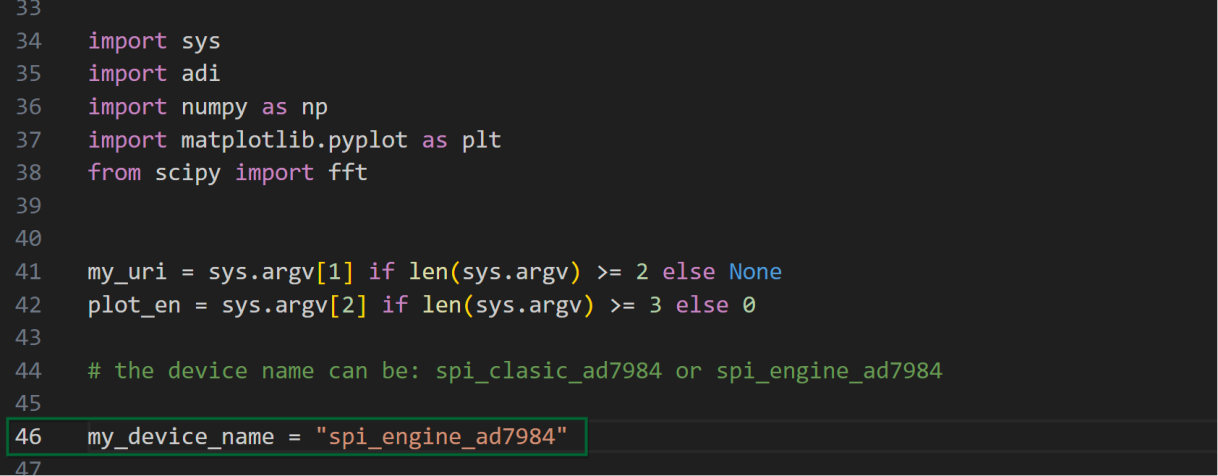

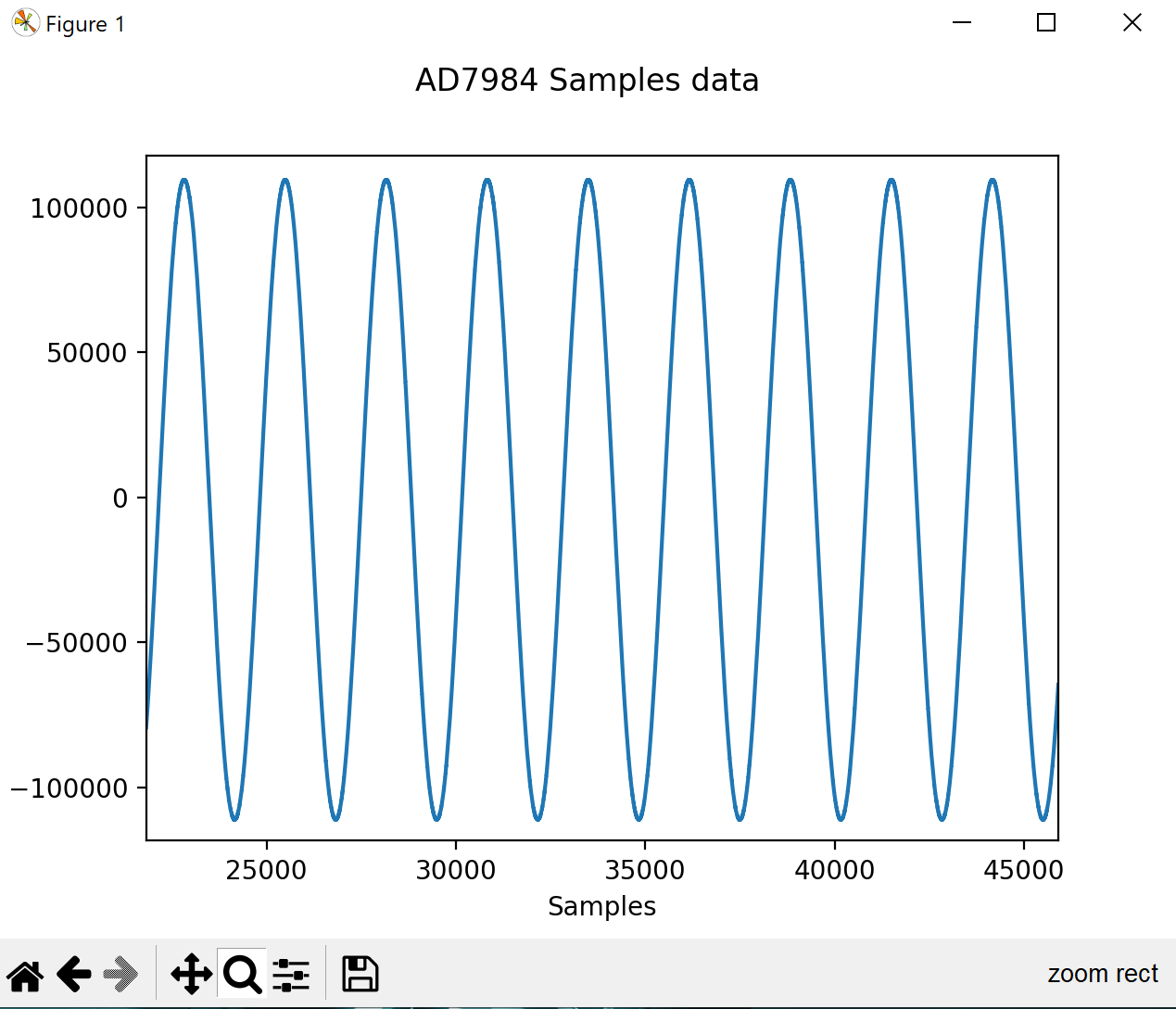
System Evaluation
Steps |
Regular SPI controller |
SPI Engine controller |
|---|---|---|
Connect IIO Oscilloscope and visualize the captured signals |
X |
X |
Run the Python script on Cora Z7S / Cygwin |
X |
X |
Analyze results in VisualAnalog |
||
Compare the results |
~$
scp root@169.254.92.202L/boot/workshop/fae_workshop_visual.vac .
root@169.254.92.202's password:analog
fae_worksop_visual.vac 100% 17KB 1.7MB/s 00:00
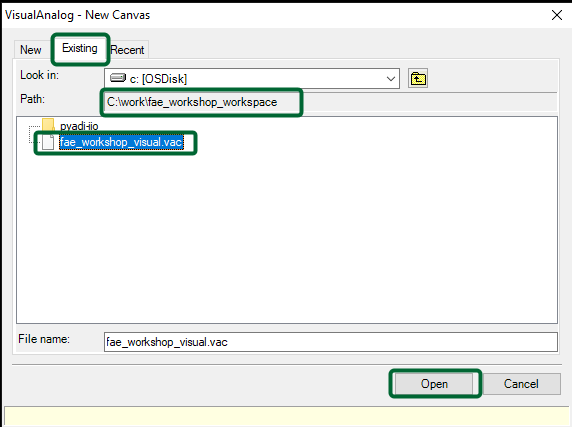
System Evaluation–Analyze results (SPI Engine-1.3MSPS)
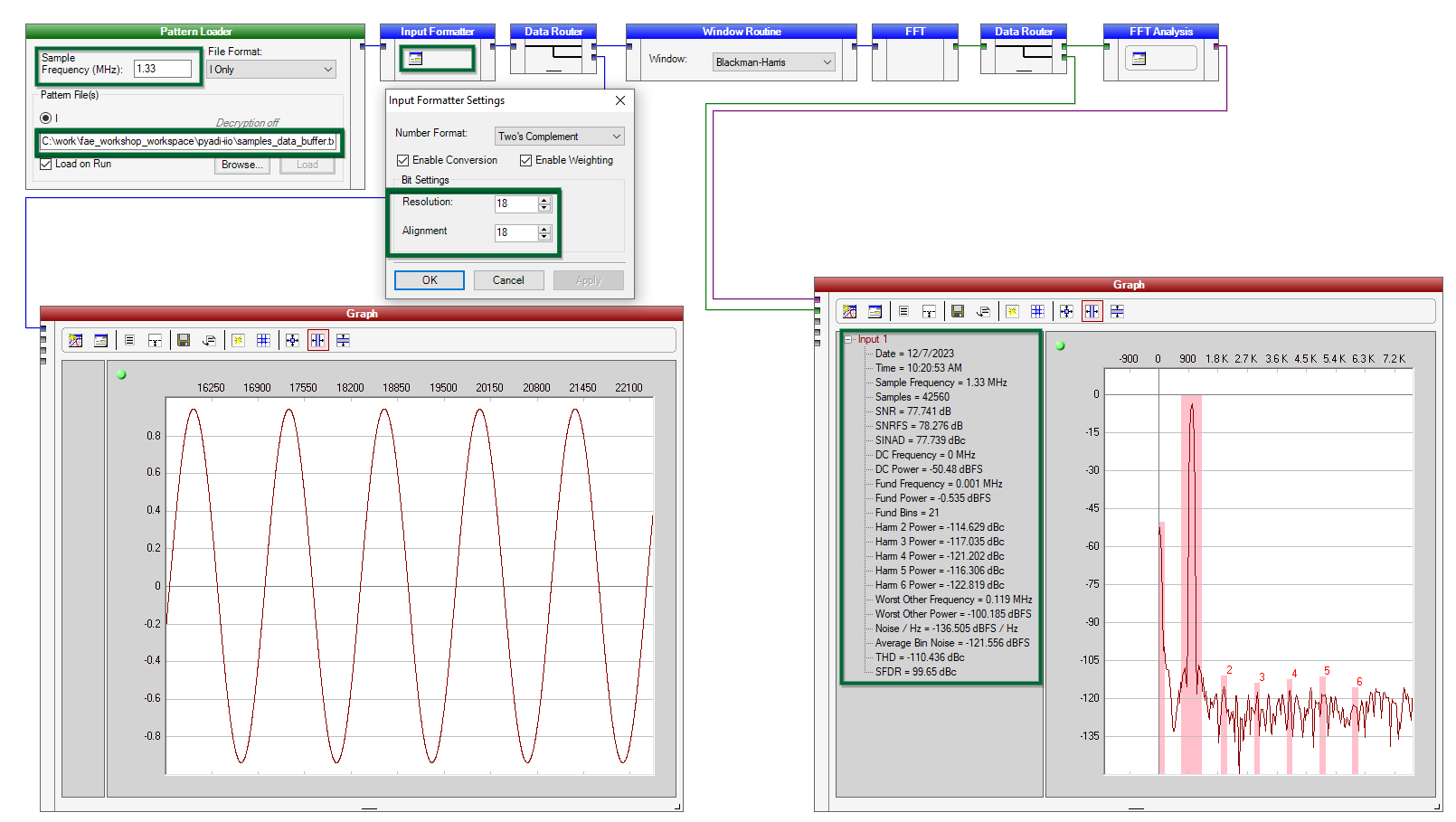
System Evaluation–Analyze results (Regular SPI -15KSPS)
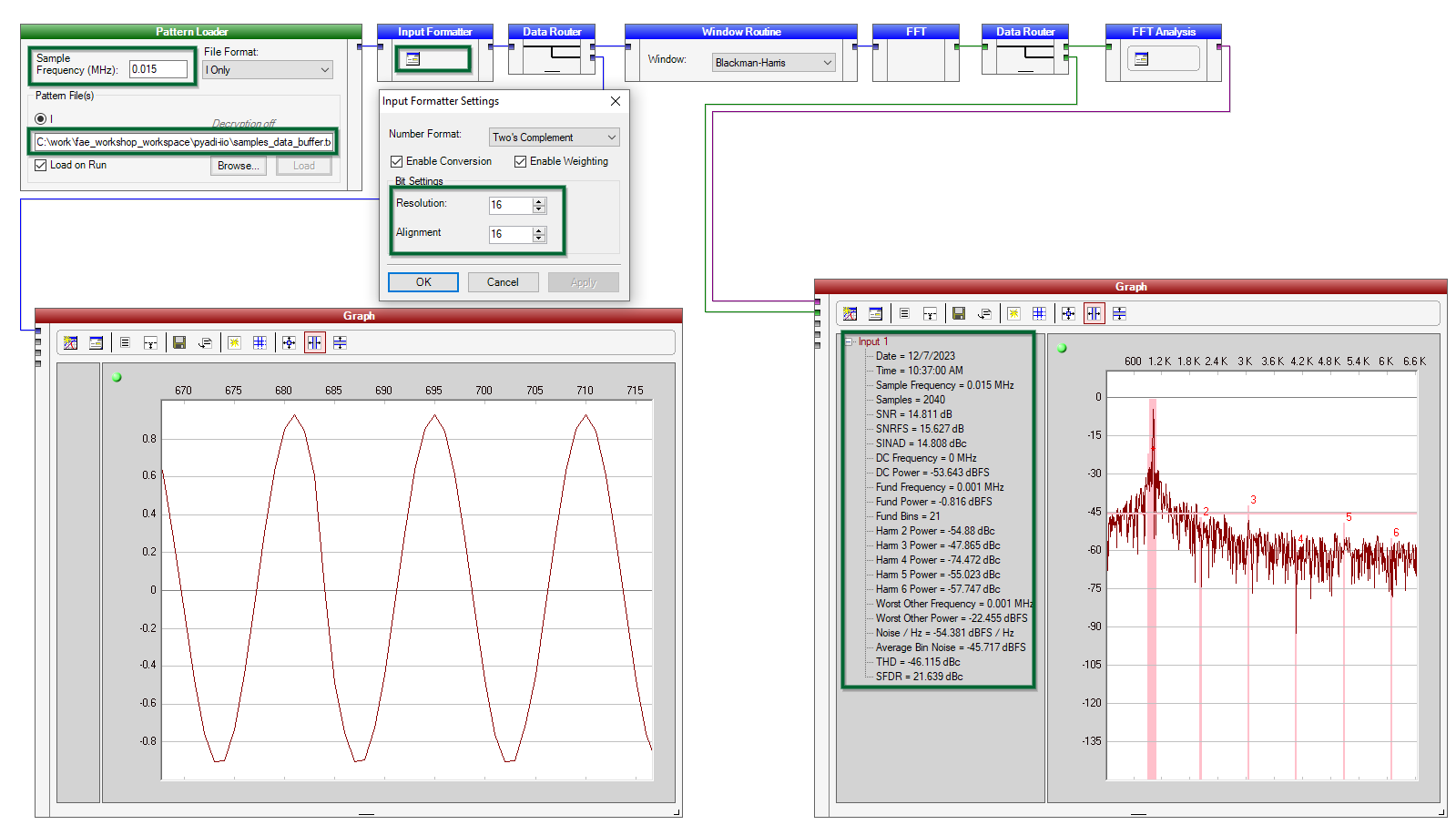
System Evaluation–Analyze results (SPI Engine-15KSPS)
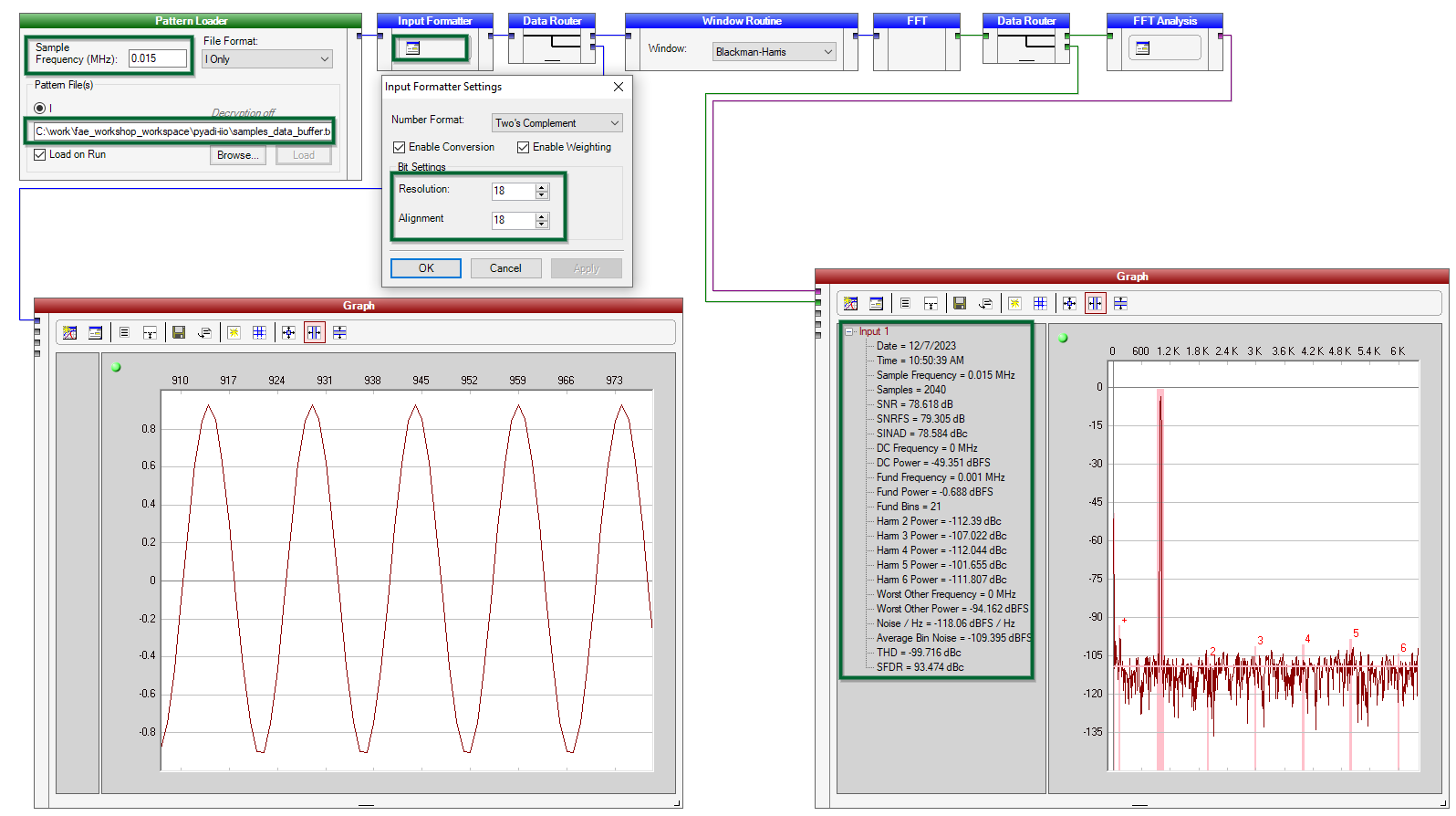
System Evaluation
Steps |
Regular SPI controller |
SPI Engine controller |
|---|---|---|
Connect IIO Oscilloscope and visualize the captured signals |
X |
X |
Run the Python script on Cora Z7S / Cygwin |
X |
X |
Analyze results in VisualAnalog |
X |
X |
Compare the results |
System Evaluation – Results comparison
Parameter |
Datasheet |
Regular SPI controller (Fin=1kHz, SR=15KHz, Ain=-0.5dBFS) |
SPI Engine controller (Fin=1kHz, SR=15KHz, Ain=-0.5dBFS) |
SPI Engine controller (Fin=1kHz, SR=1.33MHz, Ain=-0.5dBFS) |
|---|---|---|---|---|
Signal-to-Noise SNR [dBFS] |
98.5 |
14.81 |
78.60 |
77.70 |
Spurious-Free Dynamic Range SFDR [dBFS] |
112.5 |
21.13 |
92.97 |
99.15 |
Total Harmonic Distortion THD [dBFS] |
-110.5 |
-45.65 |
-99.20 |
-110 |
Signal-to-(Noise + Distortion) SINAD [dBFS] |
98 |
14.30 |
78 |
77.20 |
System Evaluation
Steps |
Regular SPI controller |
SPI Engine controller |
|---|---|---|
Connect IIO Oscilloscope and visualize the captured signals |
X |
X |
Run the Python script on Cora Z7S / Cygwin |
X |
X |
Analyze results in VisualAnalog |
X |
X |
Compare the results |
X |
X |
Conclusions
A classic MCU can be used for converters that have the sampling rate up to 100kSPS.
Maximum performance, in terms of sampling rate, SNR, THD can be only achieved with an FPGA.
SPI Engine is a highly flexible and powerful open-source SPI controller framework which can interface a wide range of precision converters.
We are now familiar with the COS group open-source solution stack.
Thank You!
Related Presentations
My customer uses an FPGA in his product. Now what?
ADALM2000 in real life applications
Just enough Software and HDL for High-Speed designs
Hardware and Software Tools for Precision Wideband Instrumentation
Questions? EngineerZone